Executive Summary
Alibaba was established in 1999 as a business-to-business (B2B) portal connecting Chinese manufacturers to overseas buyers, essentially making it easy to do business anywhere. The group has since grown to become the largest e-commerce company in the world in terms of gross merchandise volume (GMV). For the fiscal year ended March 31, 2017, Alibaba had a GMV of ¥3.8 trillion (US$0.43 trillion) and 454 million annual active buyers on its marketplaces.
In this report, we provide an overview of Alibaba’s different business segments, and how they all work together using its platforms and big data technology to enable small enterprises to compete more effectively.
Vision—“Born in China, Grow for the World”: Executive Chairman Jack Ma has a long-term vision for the company: he wants Alibaba to become a truly global company, providing solutions to real world problems and using e-commerce to help globalization by making trade more inclusive. The company’s long-term strategic goal is to serve 2 billion consumers—one-third of the world’s total population—and to support the profitable operation of 10 million businesses on its platforms by 2036. By fiscal year 2020, Alibaba expects GMV to more than double to reach US$1 trillion.
Alibaba—in it for the long haul: The group’s philosophy is to build long-term strategic value and drive synergies for its global business through organic growth and strategic acquisitions. Technology has been the driving force behind the phenomenal growth of the Alibaba economy, and will continue to drive it going forward. The group continuously incubates new business units, allowing them to gain traction and to generate sustainable cash flow.
An overview of Alibaba Group: Since its founding, the group’s operations have been anchored in core commerce, which still accounts for 72% of total revenues in fiscal year 2017. The company has since moved into new areas such as digital entertainment and local services through investments and organic growth. Our discussion is based on the broad categories of core commerce, digital media & entertainment, innovation initiatives, local services and enabling functions of commerce.
 Source: alibabagroup.com
Source: alibabagroup.com
Core commerce: Core commerce refers to the combination of retail and wholesale commerce business. There have been two notable shifts in Alibaba’s retail commerce platforms: first, from its origins as a marketplace to becoming a social commerce platform, allowing consumers to have fun exploring; and second, its move from online to offline, providing consumers with a seamless omnichannel experience.
Units: Alibaba.com, 1688.com Taobao, Tmall, AliExpress, Lazada, Juhuasuan
Digital media & entertainment: This segment was established with the aim of making the shopping experience more enjoyable for consumers. Alibaba sees strong synergies between commerce and entertainment. Thus, it has been building its content-generation ecosystem and leveraging its media assets to transform commerce and bring new users and data to the Alibaba ecosystem. The digital media and entertainment segment provides videos, movies, newsfeeds, music, sports, literature and games to consumers.
Units: Youku Tudou, UC Web, Alibaba Sports, Alibaba Pictures, Xiami
Innovative initiatives: This segment includes service offerings that aim to expand Alibaba’s ecosystem and foster a sense of community.
Units: YunOS, AutoNavi, DingTalk, Alibaba Health
Others—local services and enabling functions of commerce: This segment comprises the key infrastructure of Alibaba’s ecosystem. Technologies such as cloud computing, payments, logistics and local services which penetrate every facet of consumers’ daily lives.
 Source: alibabagroup.com
Source: alibabagroup.com
Units: Koubei, Cainiao Network, Alipay, Ant Financial, Alibaba Cloud, Alimama
Taobao—C2C Retail E-Commerce
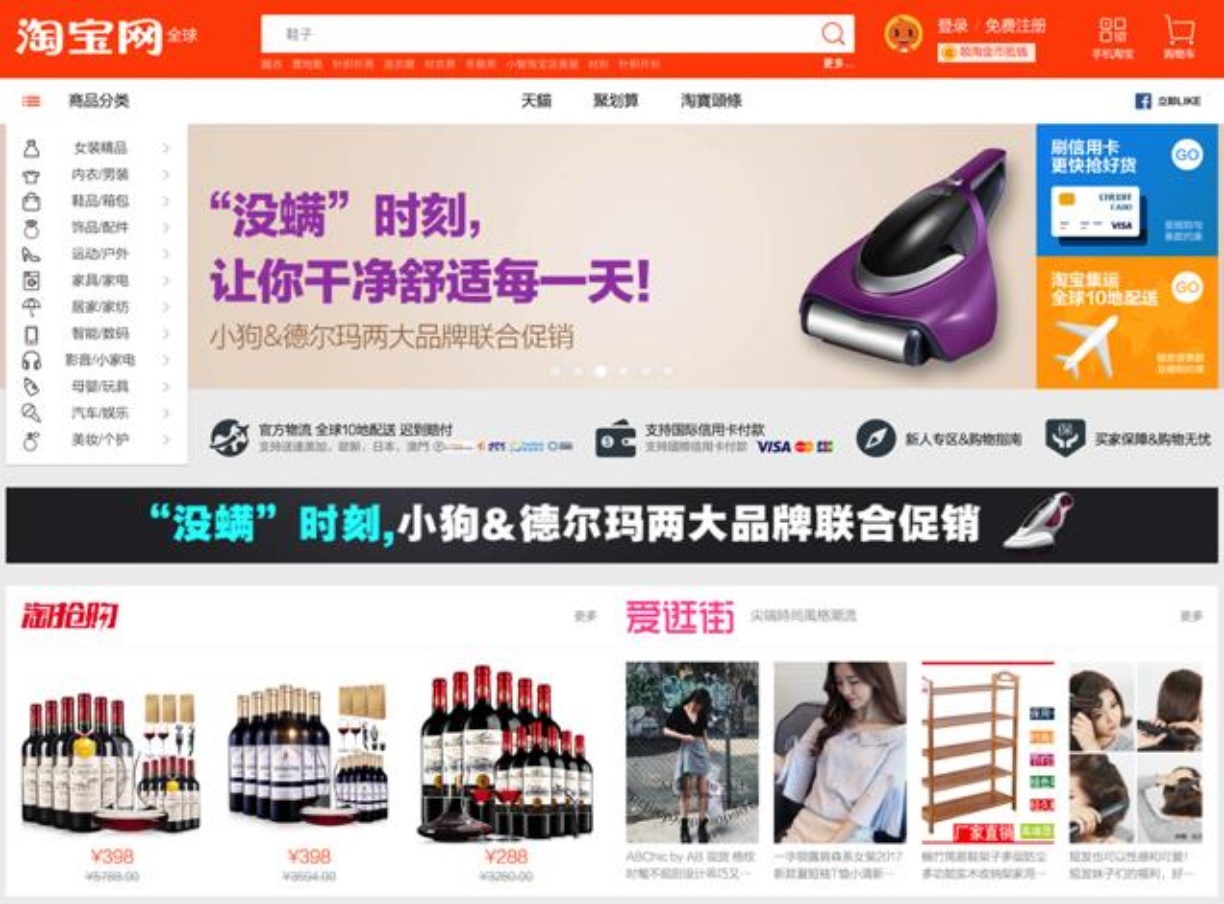 Source: world.taobao.com
Source: world.taobao.com
Business Overview
Taobao is China’s largest consumer-to-consumer (C2C) online marketplace. Sellers post items on virtual shops for buyers to browse and purchase using third-party payment provider Alipay. Buyers can search and compare products, and communicate with sellers on the Taobao website or mobile app.
Revenue model: Taobao does not charge a sales commission, but derives revenue from its value-added services (such as storefront design, marketing and promotional activities).
Strategy and Value Proposition
Taobao is China’s largest C2C sales channel and strives to be a lifestyle destination for consumers.
Ease of setting up stores: A simple registration process and minimal initial costs make it easy for small businesses and individual merchants to set up stores and start selling on Taobao.
Infrastructure: Transaction on Taobo are facilitated by Alipay’s payment infrastructure and Cainiao Network’s logistics and fulfillment capabilities.
Consumer protection against counterfeits: Consistent with Alibaba’s long-term strategy to rid its platforms of counterfeits, Taobao leverages big data technology to detect counterfeit products. Alibaba has joined forces with Chinese law enforcement authorities to arrest and sue Taobao users selling counterfeits. The escrow function of Alipay lets consumers decide to pay for items only if they are satisfied with the products.
AI and the big data-driven user experience: Taobao empowers merchants with artificial intelligence (AI) and big data technology. Big data applications include the following: Intelligent Merchant Mechanism, Intelligent Recommendation, Intelligent Personal Assistant and Intelligent Marketing. Dianxiaomi is an AI customer service chatbot designed to help sellers automate their customer service and deal with customer requests.
 Source: dianxiaomi.com
Source: dianxiaomi.com
Retail-tainment, community and content: Taobao leverages Alibaba’s ecosystem, enabling merchants to sell through social commerce. Some examples of social commerce opportunities for Taobao sellers include: Taobao Guang (a platform for female users to share photos and fashion advice); Taobao Live (a platform for merchants to promote their products through live broadcasting); and group buying with Ai Taobao and Yitao, among others. Alibaba’s video portal, Youku, and its own instant-messaging app AliWangWang, help Taobao sellers increase conversion.
 Source: alimarket.taobao.com
Source: alimarket.taobao.com
Empower innovation: Taobao is in itself an ecosystem for innovative and entrepreneurial merchants. The Taobao Maker Festival is an event that showcases innovative products and connects entrepreneurs and consumers.
Long-tail effect: Taobao boasts the widest product breadth and depth among all Chinese C2C marketplaces.
Key Metrics
GMV transacted on Taobao Marketplace in the fiscal year ended March 31, 2017 was ¥2,202 billion, a year-over-year increase of 17%, accounting for 58% of total GMV transacted on all Alibaba’s China retail marketplaces.
Together with Tmall and Juhuasuan, Alibaba’s annual active buyers reached 454 million in the fiscal year ended March 31, 2017.
Peers
Taobao has a penetration rate of over 95% in China’s C2C online retail market, according to a report by JP Morgan. EachNet and Ymatou, two competitors, are less popular and both more focused on selling foreign products.
EachNet, introduced in 2003, is a market leader in online auctions in China.
 Source: eachnet.com
Source: eachnet.com
Ymatou, established in 2009, is a cross-border e-commerce platform for B2C and C2C products.
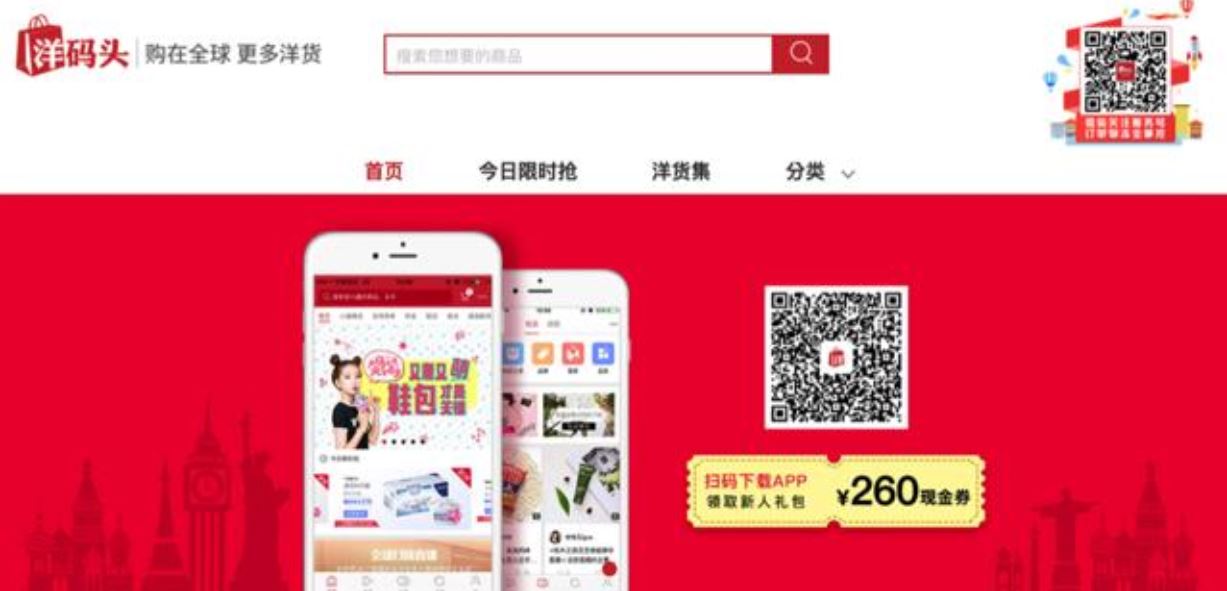 Source: ymatou.com
Source: ymatou.com
Outlook
Taobao as a lifestyle destination: We expect Taobao to continue its shift from a traditional online transactions platform to a lifestyle destination platform consisting of consumer media and a community. China’s C2C e-commerce market has been shrinking as consumers turn to B2C platforms for high-quality products. We expect Taobao to remain a central community where Chinese consumers can engage and transact.
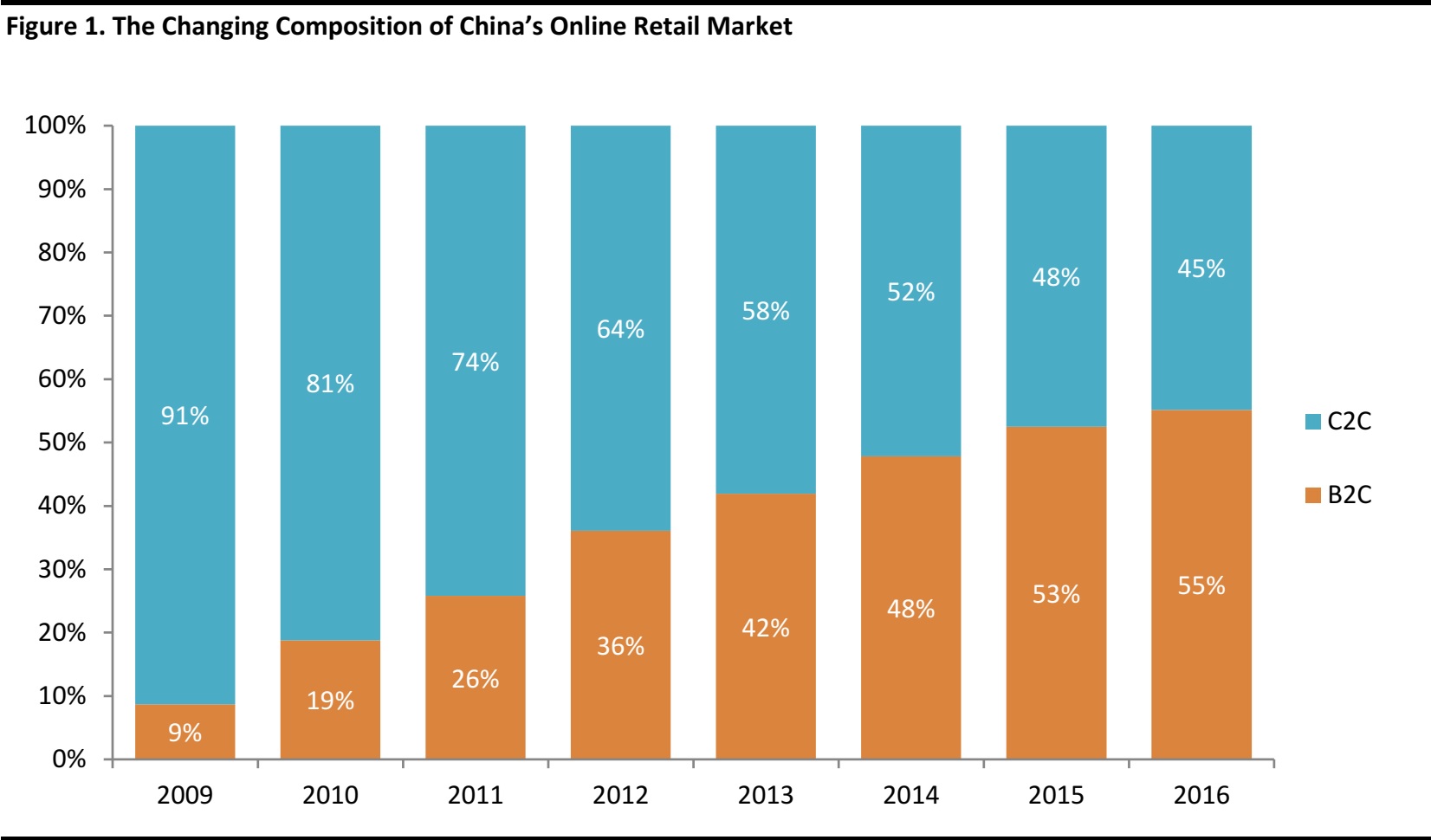 Source: Analysys
Source: Analysys
Tmall—B2C Retail E-Commerce
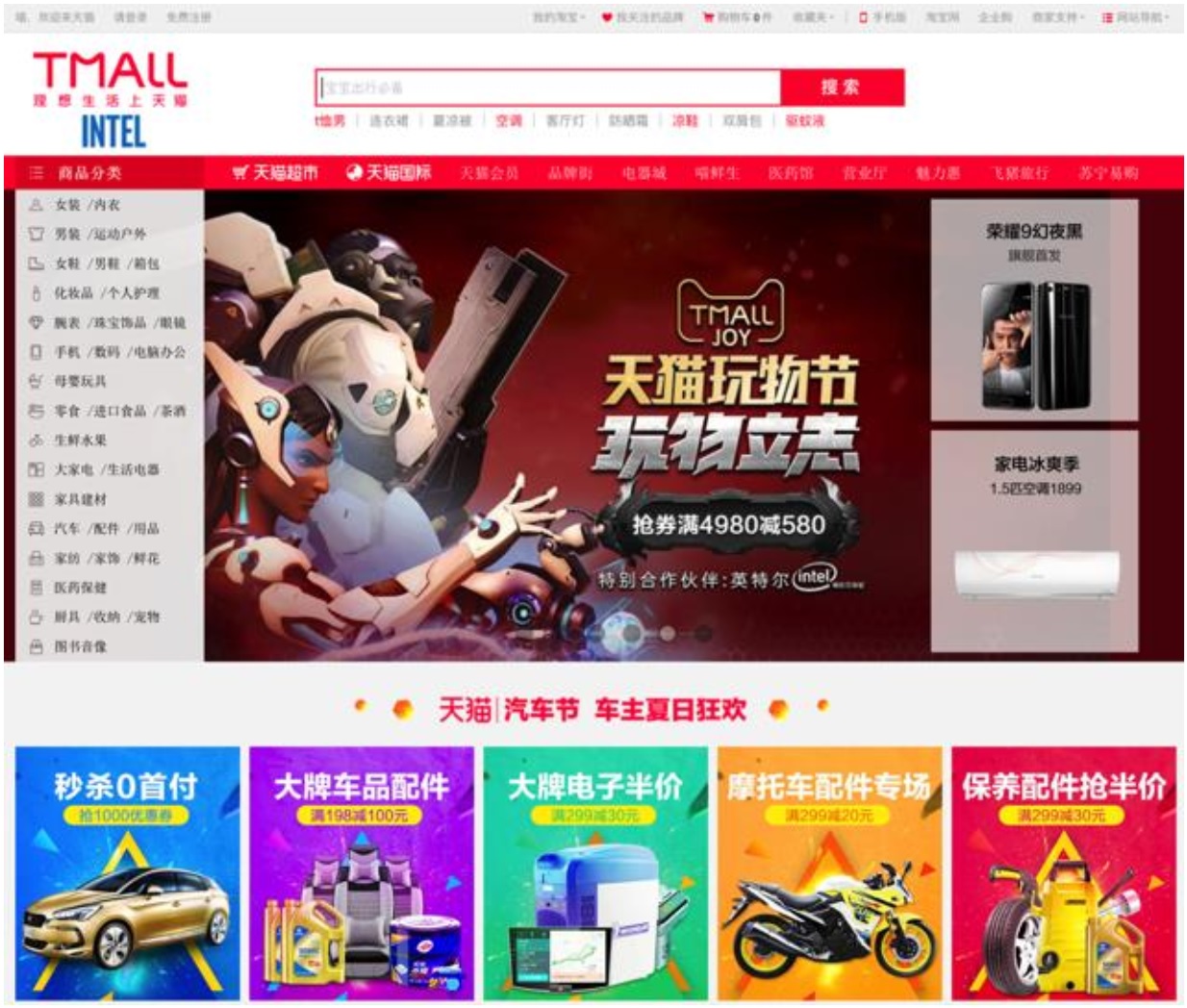 Source: tmall.com
Source: tmall.com
Business Overview
Tmall is China’s largest business-to-consumer (B2C) platform connecting global brands and retailers with Chinese consumers. Tmall offers a platform for brands to sell, build their brand image and enhance the consumer experience. It was established in 2010 and now has over 10,000 brands on its platform.
Revenue model: Tmall charges merchants an annual service fee. As well, for each transaction, it charges a commission fee based on the category of product sold.
Strategy and Value Proposition
Help brands understand Chinese consumers: Tmall’s tech-enabled tools help brands understand and effectively tap China’s fast-growing and increasingly diverse consumer base. Between 2016 and 2021, China’s consumption is forecast to increase by US$1.8 trillion to reach US$6.1 trillion, according to BCG.
Consumer engagement through innovative technologies: Alibaba helps brands engage with consumers through technologies such as big data, augmented reality (AR) and virtual reality (VR). During its annual Singles’ Day shopping festival in 2016, Tmall livestreamed a gala event and introduced the VR Buy+ channel to increase consumers’ connection with brands. Merchants on Tmall can use the platform’s big data to present targeted product recommendations and advertising to consumers.
Superior brand experience through effective marketing: Tmall lets brands connect directly with consumers by leveraging Alibaba’s media assets. The B2C platform hosts year-round consumer festivals, such as Singles’ Day, Double 12 and Tmall Super Brand Day. GMV on Singles’ Day reached ¥120 billion in 2016.
Emphasis on quality: Tmall is well positioned to benefit from China’s consumption upgrade and increasing demand for trusted and high-quality goods. Retailers must go through a vetting process to open a store on the platform and Tmall has zero tolerance for counterfeits. Tmall provides clearly defined policies for order shipment and returns handling.
The go-to channel for cross-border e-commerce: Tmall Global, Tmall’s cross-border retail platform, houses the flagship stores of international brands, enabling them to sell to Chinese consumers, regardless of whether they have a physical presence in the country.
Key Metrics
Some 75% of consumer brands on the Forbes Top 100 most valuable brands list have a presence on Tmall, as of March 2017. Approximately 200 million viewers tuned into Tmall’s Singles’ Day in 2016, almost double the 110 million viewers who watched the Super Bowl.
Peers
As an integrated B2C marketplace, Tmall had close to a 58% share of China’s B2C online retail market in 2016, followed by 26% for JD.com.
In cross-border e-commerce, Tmall Global competes primarily with JD Worldwide and Amazon.cn.
 Source: amazon.cn
Source: amazon.cn
Tmall competes with various e-tailers across different verticals. For example, it competes with VIPShop for discount luxury, Suning and Gome for electrical appliances and Dangdang for books.
 Source: Analysys
Source: Analysys
Outlook
A pivotal role in spearheading Alibaba’s New Retail: Tmall will lead the implementation of Alibaba’s New Retail initiative by integrating online and physical retail through data technology. We expect New Retail to be another growth driver for both Tmall and China e-commerce going forward.
Globalization: Alibaba is spearheading the effort to make global trade more inclusive and to remove barriers and enable small- and medium-sized enterprises (SME) to sell globally.
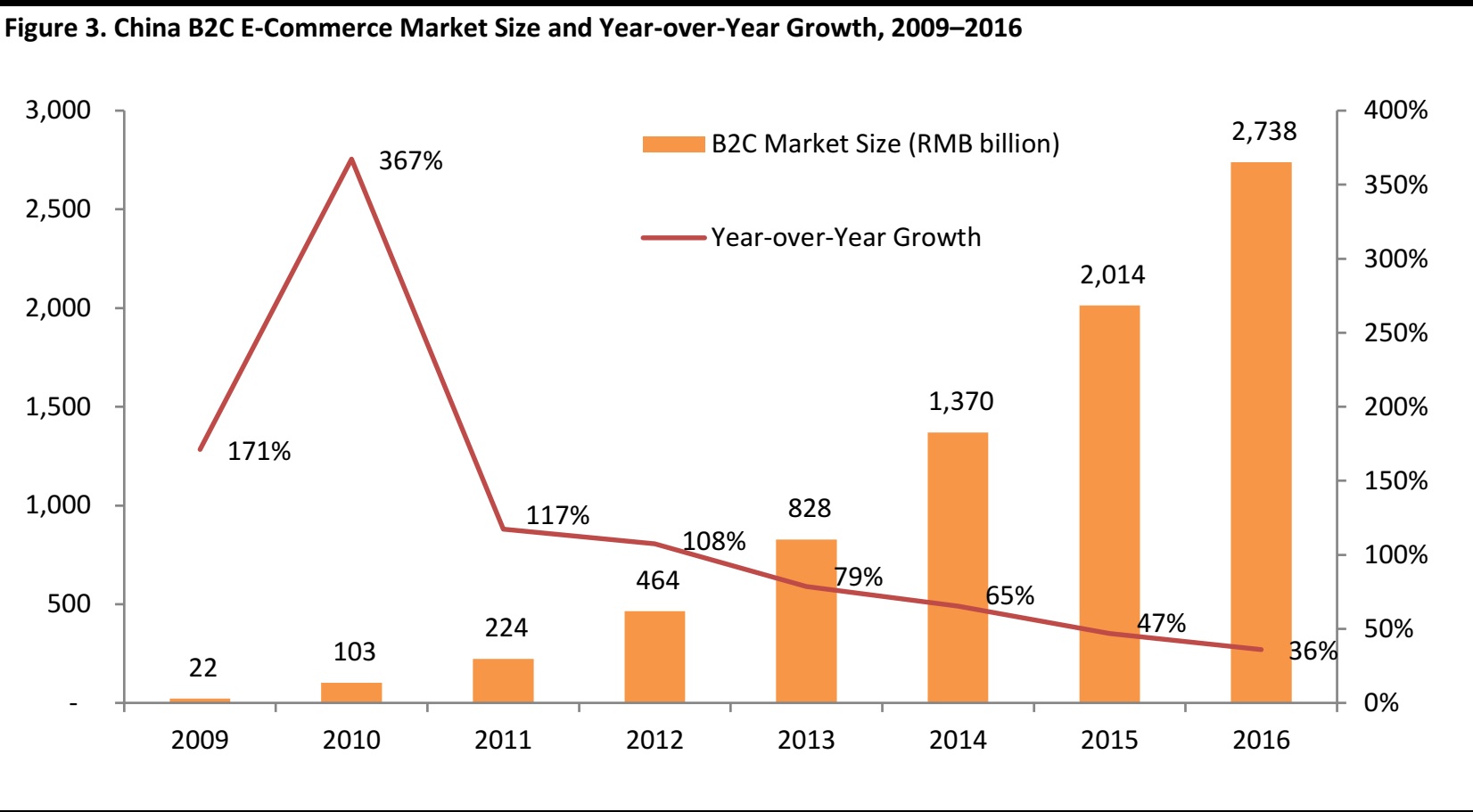 Source: Analysys
Source: Analysys
Juhuasuan—A Sales and Marketing Platform for Flash Sales
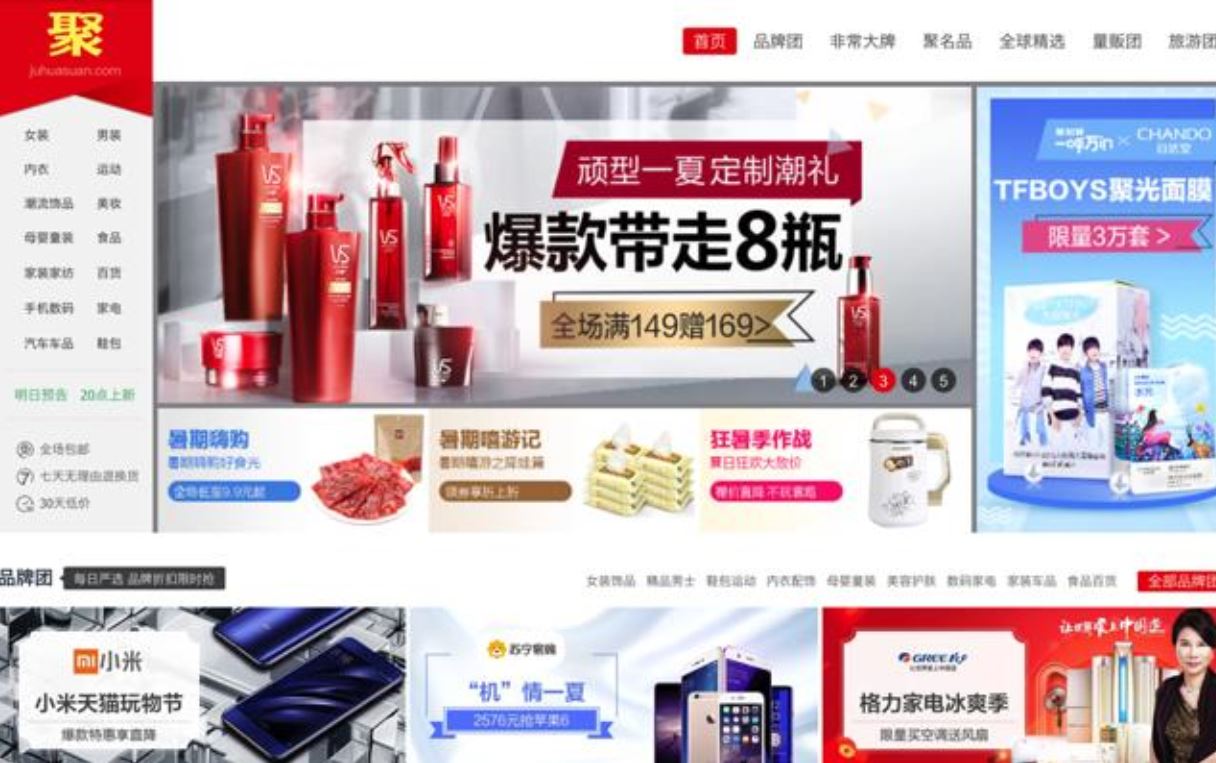 Source: ju.tmall.com
Source: ju.tmall.com
Business Overview
Juhuasuan is a leading daily deals marketplace within Alibaba that serves as an alternative avenue for Taobao and Tmall merchants to market their products. Juhuasuan uses flash sales and promotions to acquire new customers and raise brand awareness. It was established in 2010 and was integrated with Tmall at the end of 2016, yet operates under its own trade name.
Revenue model: Juhuasuan charges brands a one-time fee and commission for product listing, typically 1%–5% of the transaction value. Each product is displayed and sold for two days. Juhuasuan also charges brands for advertising services such as placing ads on its homepage.
Strategy and Value Proposition
A marketing platform that helps merchants achieve better results: Through promotional campaigns, Juhuasuan helps merchants build brand awareness, launch new products and reach new customers through promotions. Juhuasuan fits well with Chinese consumers’ preference for group buying, and has performed well during shopping festivals such as Chinese New Year, Singles’ Day and Double 12.
Competitive pricing and quality service: Juhuasuan is selective about the products it onboards, and provides customer service and delivery for users. It selects products based on their historical sales and service records. The merchant needs to guarantee a product’s pricing is the lowest for 30 days before and after the promotion. About 70% of the products offered on Juhuasuan are new or popular products.
Customer-centric products and service offerings as a competitive Advantage: Juhuasuan offers a wider range of customized products and services compared with Tmall and Taobao. In the past, it has offered unique offerings such as discounted insurance, a football lottery and luxury cruises.
Share consumer analytics data with merchants: Juhuasuan shares comprehensive consumer analytics with its merchants, which is valuable for retailers who are building their franchise and developing products for Chinese consumers.
Metrics
Juhuasuan has 30 million unique visitors daily. Some 900 products and 50 brands are displayed on the site each day, as of March 2016.
The composition of Juhuasuan’s GMV in 2016 was: fashion and apparel (32.8%), electronics (21.9%), groceries (18.6%), branded items (11.6%) and others (15.1%).
 Source: jusp.tmall.com
Source: jusp.tmall.com
Outlook
Strategic importance of marketing in the New Retail era: Juhuasuan is expected to play a significant role in helping merchants to transition to e-commerce. It was integrated with Tmall in an internal reorganization in December 2016, which will make selling and marketing on Tmall seamless—brands will launch new products through Tmall and launch marketing campaigns through Juhuasuan.
Further expand into cross-border e-commerce: Juhuasuan’s priority is to be the most effective channel for international brands to enter and launch new products on the Chinese market. Juhuasuan will give priority to overseas brands that are new to the Chinese market. With the inclusion of overseas brands, it will help to expand the breadth and depth of its product offerings.
Peers
Juhuasuan’s peer group consists of C2B social commerce platforms such as Pingduoduo, Juanpi and Jumei.
1688.com—China’s Online B2B Wholesale Marketplace
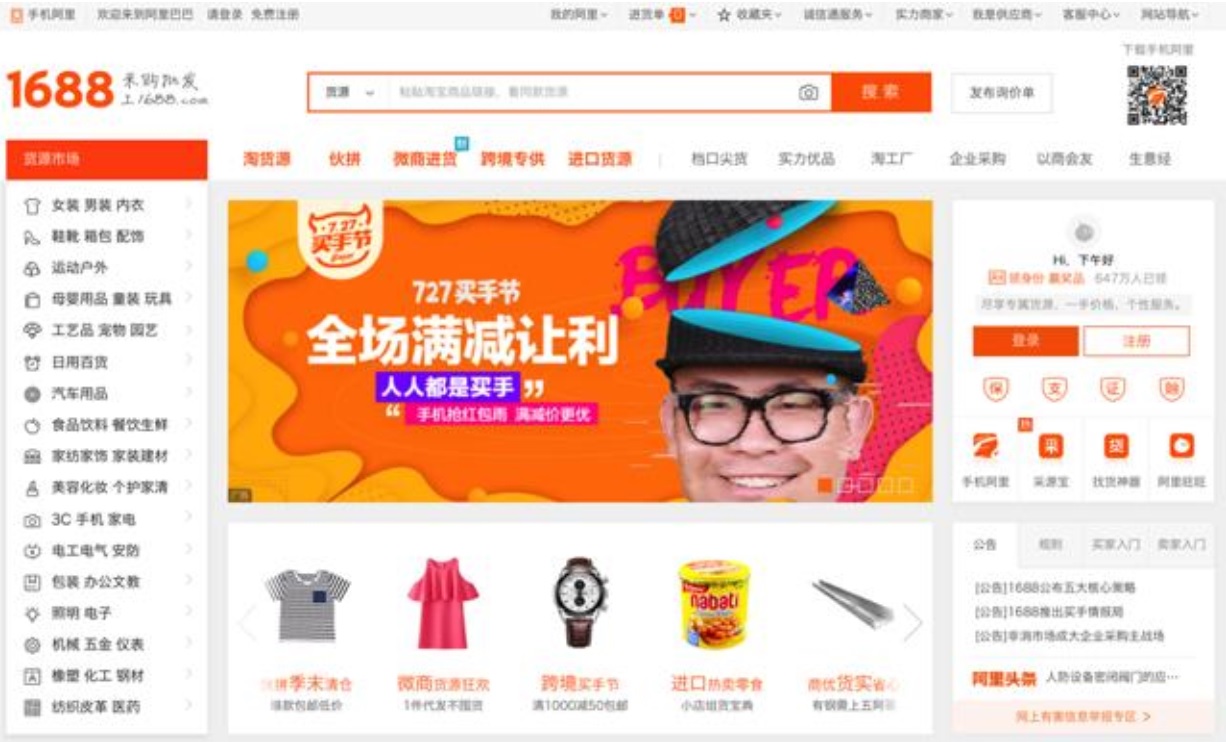 Source: 1688.com
Source: 1688.com
Business Overview
1688.com is an integrated B2B platform that connects local buyers and sellers for trade of general merchandise, raw materials, and industrial and chemical products, among others. Launched in 1999, it is a pioneer in China’s wholesale B2B market.
Revenue model: 1688.com charges an annual membership fee as well as fees for value-added services (such as promotional and advertising fees, and order matching fees).
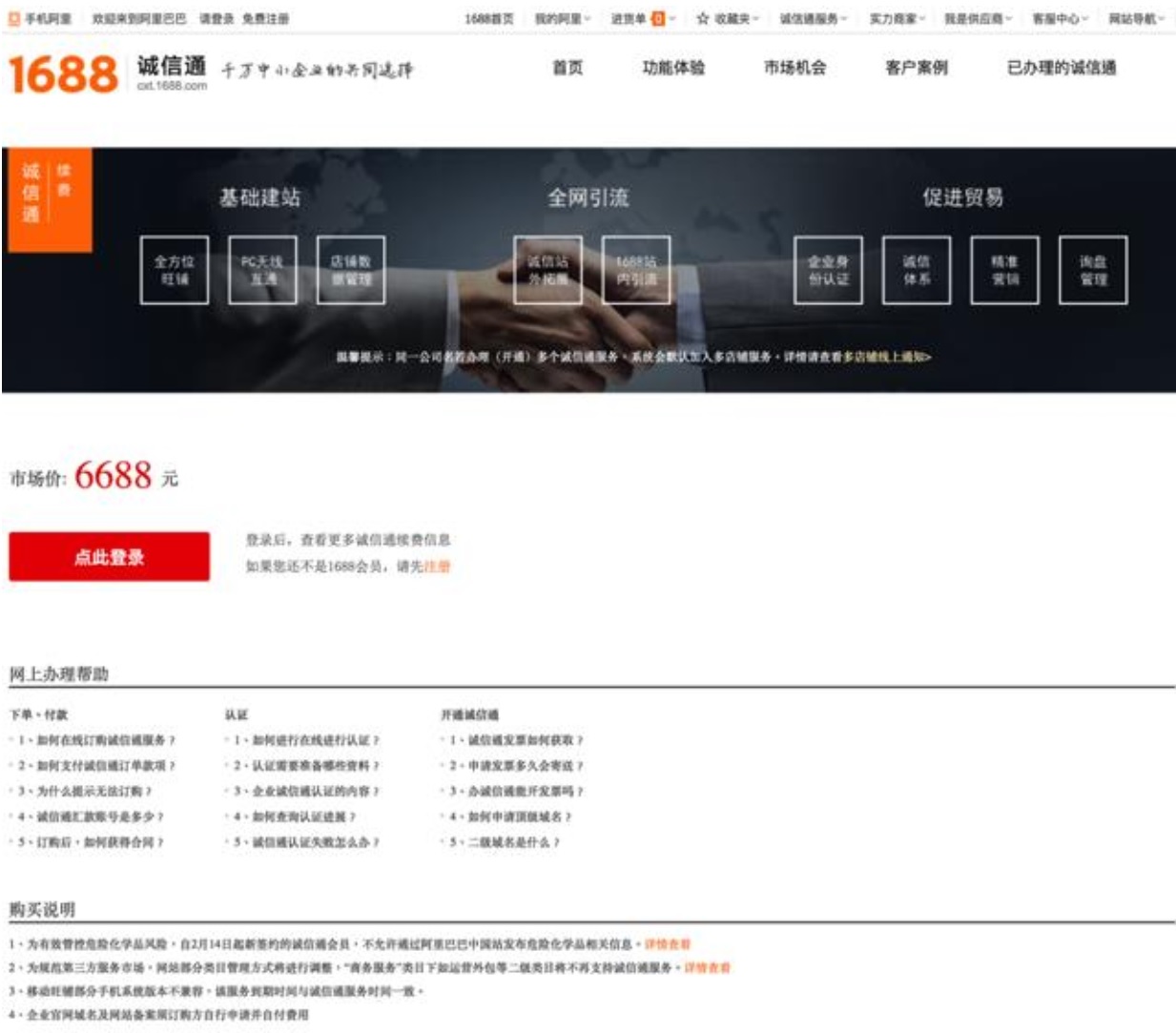 Source: cxt.1688.com
Source: cxt.1688.com
Strategy and Value Proposition
Effective online sourcing channel for merchants: 1688.com serves the upstream value chain, which includes retailers and merchants on Taobao. The key characteristics of 1688.com are attractive prices and higher transaction volume. It is common for buyers to buy the same product at a fraction of the price when purchasing in bulk from 1688.com.
Value-added membership services for suppliers: 1688.com provides membership services such as exhibition spots at conferences, advertising, data analytics and other functions through China TrustPass. It also provides advertising services such as pay-for-performance (P4P) marketing and keywords auctions.
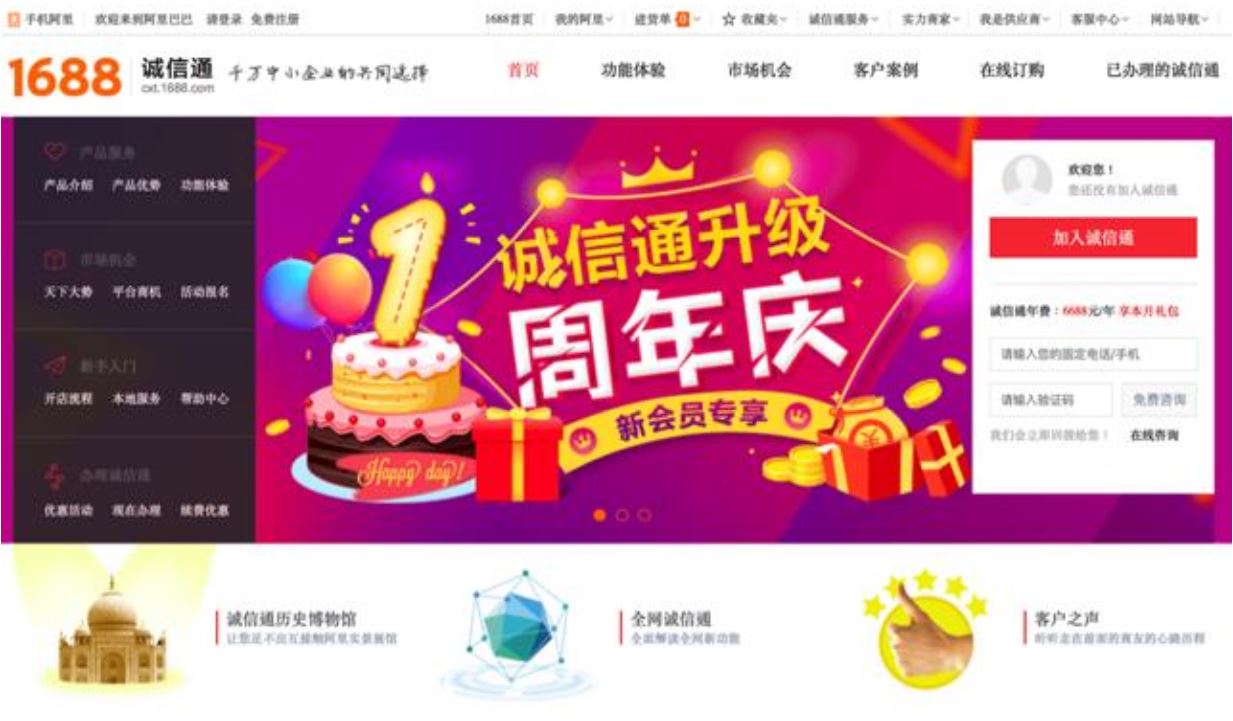 Source: cxt.1688.com
Source: cxt.1688.com
Community: 1688.com provides an online community for merchants and suppliers to share advice and field queries. It is China’s largest B2B sourcing platform, given its first-mover advantage.
Metrics
1688.com had over 961,000 paying members as of March 31, 2017, and 230 million suppliers, as of March 31, 2016.
Approximately 60% of its orders are from businesses outside Alibaba’s e-commerce platforms such as Taobao and Juhuasuan.
Peers
Peers of 1688.com’s B2B e-commerce platform include HC360, makepolo, Global Sources and DHGate.
 Source: hc360.com
Source: hc360.com
Outlook
Continued digitalization: 1688.com will continue to drive more value creation for SMEs through digitalization. 1688.com aims to become China’s most-efficient SME trading platform within three years, and China’s No.1 SME trade data-sharing platform within five years.
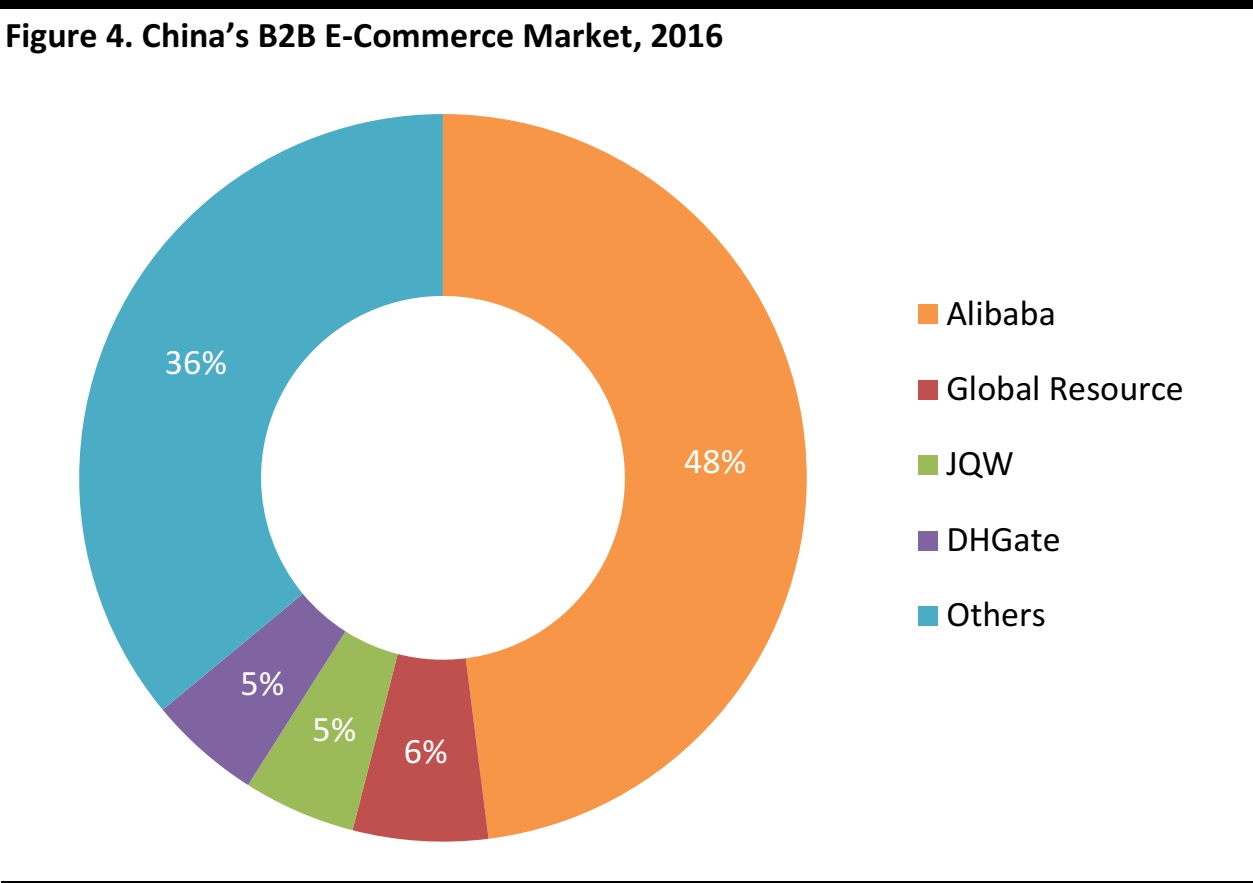 Source: iResearch
Source: iResearch
AliExpress—Global B2C Online Marketplace
 Source: aliexpress.com
Source: aliexpress.com
Business Overview
AliExpress is an international B2C marketplace for overseas consumers to buy directly from manufacturers and distributors in China. It was launched in 2010 and is the third-largest English online shopping website globally, covering over 200 countries and operating in 16 local languages.
Revenue model: Registration is free. AliExpress charges merchants an annual fee and a 5% commission for each transaction.
Strategy and Value Proposition
Expedited delivery supported by a data intelligent network: Orders placed on AliExpress are delivered by Cainiao’s cross-border fulfilment and delivery network. Cainiao’s open data technology platform is supported by automation, smart devices and AI, and has led to increased efficiency. For example, delivery time in Russia saw a 20% improvement in fiscal year 2017.
Tech-enabled tools for effective selling: AliExpress has a suite of apps for payment, translation and communication to help Chinese merchants interact with overseas customers more effectively.
Retail with entertainment: AliExpress has integrated entertainment elements into the platform to enhance consumers’ shopping experience and their interaction with brands. Consumers can tune into AliExpress LIVE to interact with cewebrities and brands who livestream their content. Livestreaming is also used during shopping festivals for brands to engage with consumers.
Key Metrics
AliExpress had more than 100 million overseas buyers from 220 countries and regions, as of April 2017.
On Singles’ Day 2016, AliExpress handled 35.8 million orders, a year-over-year increase of 68%, covering 230 countries and regions.
The top-five markets by transaction value for AliExpress are: Russia, the US, Spain, Brazil, France and the UK. AliExpress is one of the most popular cross-border e-commerce marketplaces in Russia.
The top-five product categories by transaction value are: fashion and accessories, phones, cosmetics and health, computers, jewelry and watches.
Peers
Peers include Amazon and eBay.
Amazon is the largest online retail marketplace in the US by total sales. It has sellers from more than 130 countries and customers in 185 countries.
 Source: amazon.com
Source: amazon.com
eBay is an online C2C and B2C platform that operates in approximately 30 countries.
 Source: ebay.com
Source: ebay.com
Outlook
Strengthen brand building and globalization efforts: The future strategy of AliExpress is to serve more customers globally to align itself with the mission of Alibaba. AliExpress aims to further support Chinese merchants’ expansion efforts overseas in areas including marketing, brand-building, logistics, financial and value-added services.
Alibaba.com—Global Online Wholesale Marketplace
 Source: alibaba.com
Source: alibaba.com
Business Overview
Alibaba.com is China’s largest global online wholesale marketplace and is the international version of 1688.com. Alibaba.com, which is in English, serves buyers from over 200 countries by connecting them with suppliers in China. Combined, 1688.com and Alibaba.com are the biggest domestic and international B2B wholesale marketplaces globally.
Revenue model: Alibaba.com does not charge a commission. It generates revenue from membership fees, marketing services and value-added services.
Strategy and Value Proposition
An effective channel for domestic suppliers to export to the rest of the world: Alibaba.com helps domestic suppliers enter the international market through product listings, promotional campaigns and order matching.
Digitizing global trade: Through solutions and partnerships, One Touch, an affiliated import and export service, provides import/export business solutions such as custom clearance, value-added tax (VAT) refunds and other value-added services. Alibaba.com has partnerships with domestic third-party logistics providers and international players such as UPS, Fedex, Maersk, DHL and Kuehne + Nagel to boost cross-border logistics operations.
 Source: home.kuehne-nagel.com
Source: home.kuehne-nagel.com
Quality assurance for global buyers: Alibaba.com launched the Trade Assurance Program in order to create trust and attract overseas buyers. Buyers are eligible for refunds related to quality issues. Alibaba OneTouch vets suppliers that wish to participate.
Financing support enabled by data technology: “e-Credit Line” provides trade financing to small businesses buying and selling on Alibaba.com. The credit financing decision is powered by an automated credit scoring system that is able to grant full approval within 24 hours.
Peers
Alibaba.com is the largest B2B marketplace globally in terms of GMV. It has 18 million buyers, followed by ThomasNet in the US (1.8 million buyers), TradeIndia in India (1.6 million buyers) and EC21 in South Korea (1 million buyers).
 Source: thomasnet.com
Source: thomasnet.com
Metrics
As of March 31, 2017, Alibaba.com has over 141,000 paying members.
Outlook
Globalization: Alibaba.com will play a pivotal role in supporting the Electronic World Trade Platform (eWTP) initiative promulgated by Chairman Jack Ma. The vision of eWTP is to lower trade barriers for SMEs and make global trade frictionless.
 Source: alibabagroup.com
Source: alibabagroup.com
Lazada—South-East Asia Based E-Commerce Platform
 Source: lazada.com.my
Source: lazada.com.my
Business Overview
Lazada is an e-commerce platform focused on South-East Asia, with operations in Singapore, Indonesia, Malaysia, the Philippines, Thailand and Vietnam. It operates a marketplace model that allows third-party retailers to sell their products on the Lazada platform (since 2013) and also sells inventory directly to customers from its own warehouses.
Lazada was launched by Rocket Internet in 2012 and is currently 83% owned by Alibaba.
Revenue model: Lazada derives revenues primarily from commissions. It charges a 2% payment fee and a commission on products sold on its marketplace that ranges from 0.5% to 12%. Other revenue streams include advertising.
Strategy and Value Proposition
An e-commerce leader in South-East Asia: Lazada gives Alibaba exposure to the rapidly-growing South-East Asia e-commerce market, without having to build a site from the ground up. Online shopping accounts for less than 5% of the region’s retail sales currently, and this share is expected to increase. B2C online retail sales are estimated to increase at a compound annual growth rate of 17.1% to US$25 billion in 2020 from US$11 billion in 2015, according to Frost and Sullivan.
Synergies between Lazada and Alibaba’s ecosystem: The cooperation between Alibaba and Lazada has been mutually beneficial, helping both players to tap into an expanded customer base, broadening their product range and capabilities. Lazada has onboarded Tmall brands to its marketplace and enabled its merchants to sell through Taobao, increasing the choice of both consumers and merchants. Lazada’s logistics capabilities are strengthened, as it can now tap into Cainiao Network for logistics services.
Key Metrics
Lazada’s GMV for the Double 12 shopping festival in 2016 was US$40.5 million.
Peers
Lazada is the dominant e-commerce player in South-East Asia. Other local players include
Tokopedia, an Indonesian online C2C marketplace launched in 2009, and
Shopee, a Tencent-backed platform based in Singapore. Other global marketplaces are also interested in entering the market.
JD.com announced plans to expand to Thailand before the end of 2017.
Amazon has also been reported to be planning to enter South-East Asia.
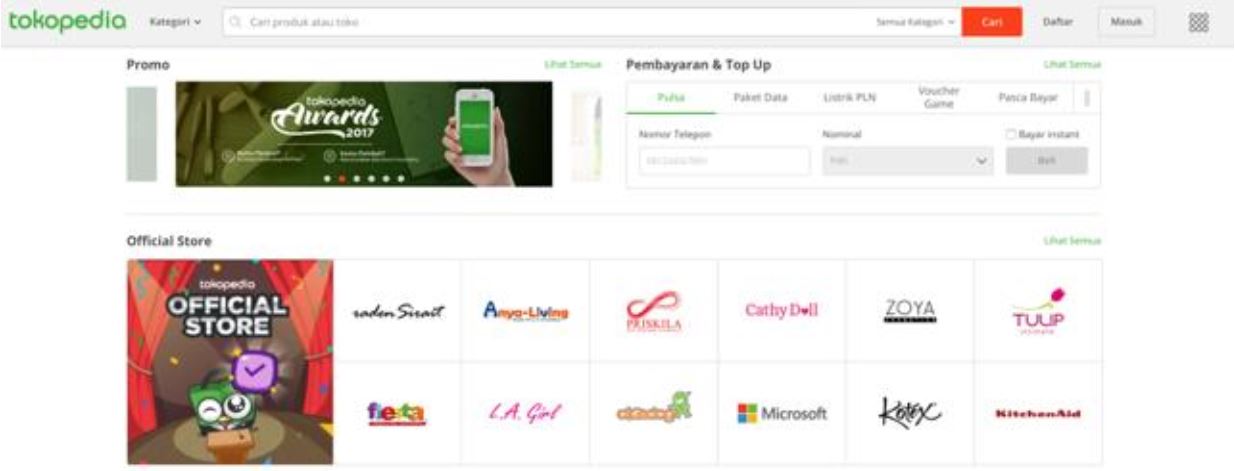 Source: tokopedia.com
Source: tokopedia.com
 Source: shopee.sg
Source: shopee.sg
Outlook
Global expansion strategy: Alibaba’s strategy is to transform Lazada into a global marketplace from a South-East Asia marketplace. Lazada is also focusing on adding smaller merchants to its online marketplace. This is part of Alibaba’s long-term vision to reach GMV of US$1 trillion by 2020 and to increase its revenue contribution from outside of China to 50%
Alibaba Pictures—Digital Media and Entertainment
 Source: alibabapictures.com
Source: alibabapictures.com
Business Overview
Alibaba Pictures (Ali Pictures) is the movie production and distribution arm of Alibaba. It produces, invests in and distributes movies and TV programs, and operates an online ticketing platform in China. Invested in by Alibaba in 2014, Ali Pictures is majority owned by Alibaba Group and trades on the Hong Kong Stock Exchange under the ticker 1060 HK.
The four main areas of operation are: 1) movie studio, content creation and production; 2) Internet-based marketing and distribution; 3) entertainment e-commerce; and 4) international.
Revenue model: Ali Pictures generates revenue from commissions and service fees charged on marketing and ticketing for third-party films (75% of its revenue in 2016), box office income from its proprietary film productions (23% of revenue) and others (2% of revenue).
Strategy and Value Proposition
Full coverage of the film industry value chain: The operations of Ali Pictures span the entire film industry value chain, from financing and production of films to marketing, distribution and ticketing.
Platform-oriented approach: Ali Pictures aims to create an integrated O2O platform for the entertainment industry by connecting the offline cinema circuit and online distribution. Ali Pictures has a strategic cooperation agreement with Alibaba for three years to pool resources to co-develop content.
The cooperation lets it leverage the assets of the Alibaba ecosystem:
- Alibaba will grant exclusive rights of work from Alibaba Literature, Alibaba Gaming and Youku to Ali Pictures.
- Alibaba’s media assets such as the video streaming site Youku Tudou, OTT (subscription content business) Tmall Box Office and Taobao online ticketing Tao Piaopiao can help make content distribution more effective.
- Alipay can make payment for content more streamlined.
International presence: Ali Pictures aims to produce content for a global audience. It invested in Amblin Partners to co-produce and distribute movies, and has partnerships with Hollywood studios such as Paramount Pictures and Skydance Media. Ali Pictures is also committed to developing its business in India and has been connected to several investments there.
Digital marketing and data analytics: Consumer data and insights generated from the Alibaba ecosystem will support targeted marketing efforts for Ali Pictures. Furthermore, Alibaba also invested in film data analytics and content distribution platforms to increase user engagement and market share.
Focus on IP and made-for-Internet content: Ali Pictures will focus on Internet dramas as the key growth area, given the rapid growth of online video streaming, which will become an important channel for content distribution. It has been investing in a platform to provide online movie content creators with open IPs and resources. Ali Pictures also operates Yulebao, a C2B film production platform, to provide resources for financing, licensing and marketing.
 Source: taobao.com
Source: taobao.com
Key Metrics
Ali Pictures’ online ticket platform Tao Piaopiao had over 25 million MAU, as of June 2016, and the daily maximum number of tickets sold reached 3 million.
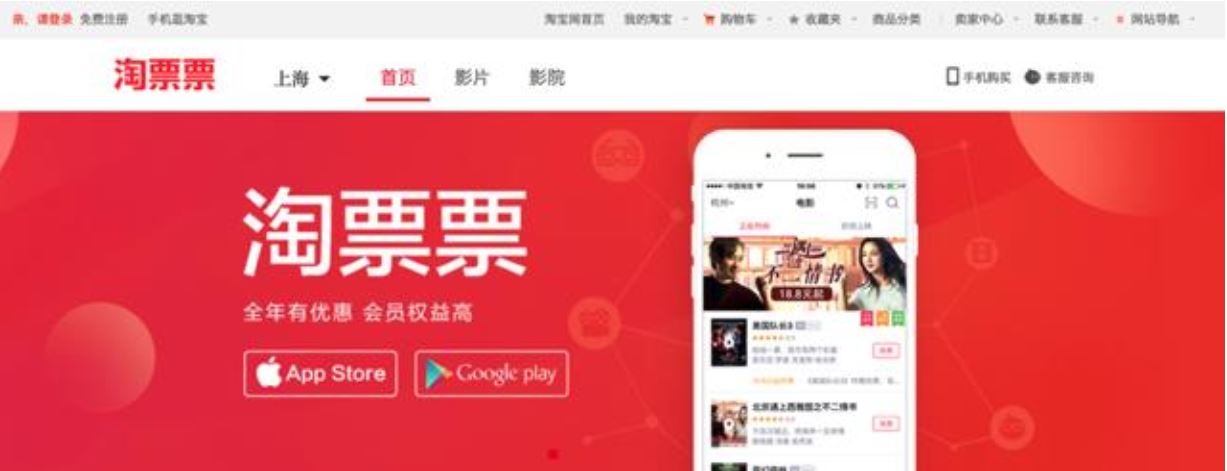 Source: dianying.taobao.com
Source: dianying.taobao.com
Its software solution YKSE has over 1,000 theatre clients, among which, 60% have annual box office revenues of over ¥10 million.
Peers
Ali Pictures’ peers include China’s largest film companies, such as AMC Entertainment, Huayi Brothers, Tencent Pictures and cinema operator Wanda Cinema Line.
 Source: huayibrothersent.com
Source: huayibrothersent.com
Outlook
Strive for sustainable profitability: Ali Pictures will seek a sustainable profit model and high-quality productions to drive further growth. China’s box office revenue in 2016 was ¥46 billion, the second-largest movie market after the US, and is estimated to reach ¥86 billion in 2018, according to iResearch. However, Chinese box office growth has been decelerating following the jump in box-office revenues in 2014 and 2015, which was attributable to lower-priced tickets on online platforms.
Invest for growth: Ali Pictures has been expanding its film ecosystem through acquisitions in film and TV production, distribution and ticketing, which we believe will increase its competitiveness. The company has an investment fund aimed at building assets across the film-production chain. Recent investments include the Dadi cinema chain to strengthen distribution; producer and distributor Bona Film Group; film financing group Hehe Film; Amblin Partners; and digital marketing platform Damai.
Film co-productions with overseas studios: Ali Pictures is expected to lead co-production with Hollywood and investments in foreign films, following its strategic partnership on co-production with Steven Spielberg’s Amblin Partners.
Xiami—Music-Streaming Platform
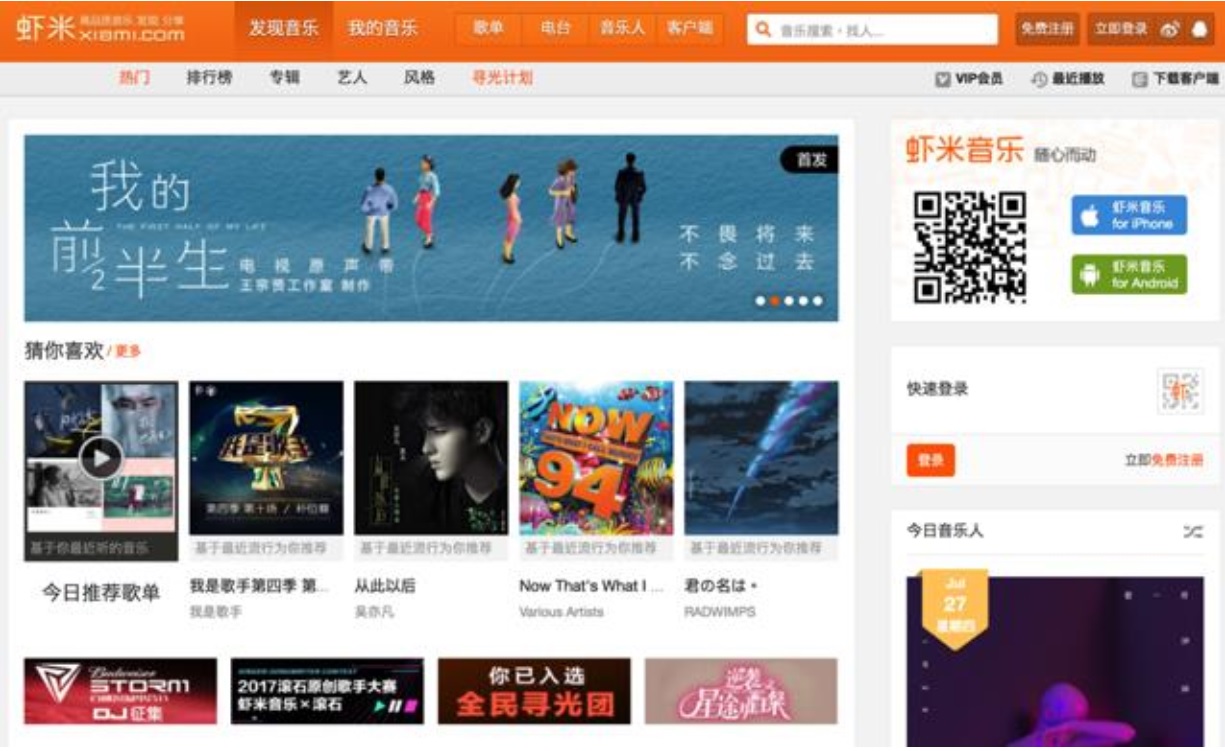 Source: xiami.com
Source: xiami.com
Business Overview
Xiami is a music-streaming platform under Alibaba’s music division. It was founded in 2006, acquired by Alibaba in 2013 and integrated with Tiantian to form the Alibaba Music Division in 2015.
Revenue model: Xiami earns fees from advertising and paid subscriptions for its music-streaming services, similar to Spotify.
Strategy and Value Proposition
Global strategic partnerships: Xiami, part of Alibaba’s music division, has international and domestic licensing partners, including Universal, BMG and K-Pop record label SM Entertainment.
Use of technology to foster community: The Xiami platform provides support to independent Chinese musicians and helps them get discovered.
Platform approach: Xiami is able to leverage Alibaba’s assets, which cover marketing and advertising, payments, e-commerce, etc.
Peers
Peers are major music-streaming platforms in China, which include NetEase Cloud Music, QQ Music, Sogou Music, Kugou Music, Kuwo Music, Baidu Music, Yinyue Tai, etc.
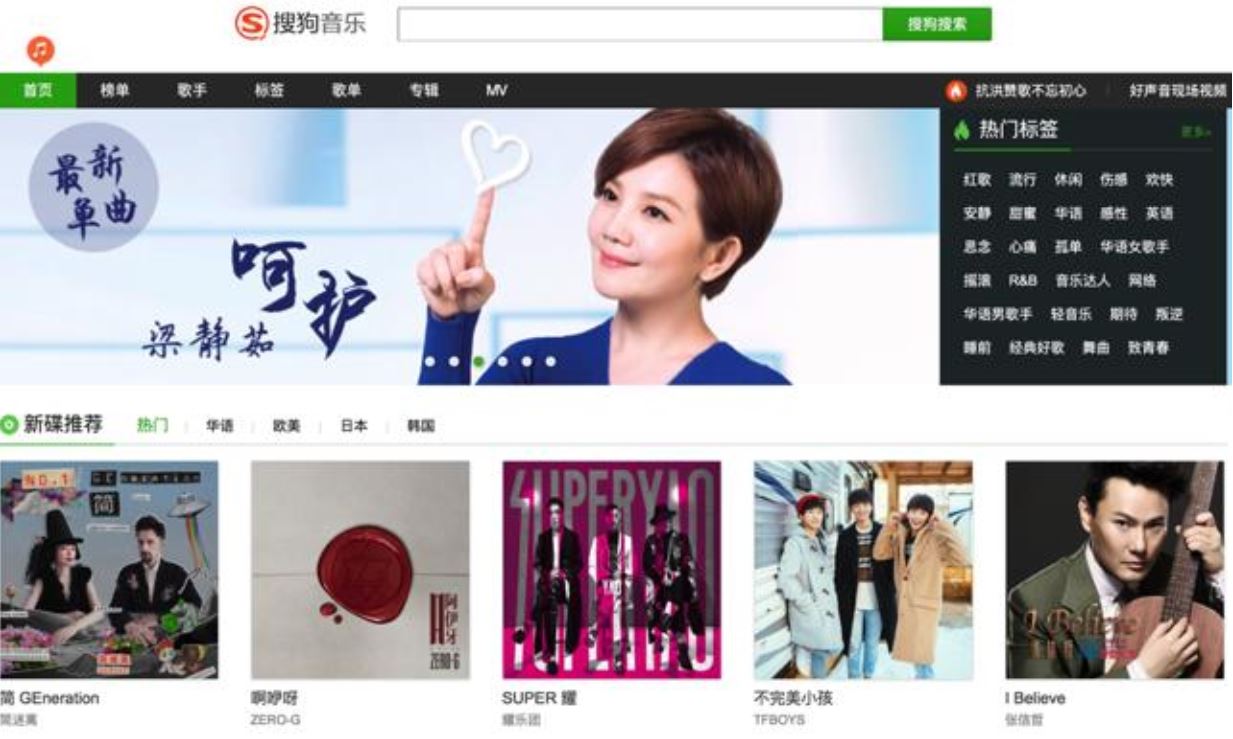 Source: mp3.sogou.com
Source: mp3.sogou.com
Metrics
Xiami Music has over 14 million MAU, as of September 2016, according to QuestMobile. The Xiami Music mobile app has been installed on 9 million devices, as of December 2016.
Outlook
Structural growth story: China’s music-streaming industry is forecast to grow rapidly through to 2020, according to Analysys. The structural growth trend is primarily driven by consumers’ increasing willingness to pay for high-quality audio content, rising income levels and widespread access to cloud storage and 4G/5G networks.
Policy support: Xiami will continue to benefit from the Chinese government’s cultural development strategy to support multimedia content.
License infringement remains a risk for music-streaming platforms in China. Xiami’s services were suspended briefly in 2015, as it was embroiled in music copyright disputes with regulators. Xiami has proactively mitigated the risk by obtaining legal rights for music catalogs.
Alibaba Sports—B2B Sports and E-Sports Platform
 Source: alisports.com
Source: alisports.com
Business Overview
Established in 2015, Alibaba Sports (Alisports) develops and operates sports IP, sporting events, e-sports contests, sporting venues, sports merchandise and acquisitions of selected media rights.
Revenue model: Alisports is currently focused on scaling up and expanding the reach of its infrastructure. Based on its business nature and vision, we expect it to derive revenue in the future from commissions from Alisports’ online platform and advertising income from sporting events.
Strategy and Value Proposition
Digitalize and create a platform for China’s sports economy: Alisports’ vision is to digitalize the traditional sports industry by leveraging Alibaba’s digital assets and user data. Alisports will integrate the group’s assets in e-commerce, media, marketing, video, entertainment, cloud computing and AI, with event management, IP, business development, ticketing, etc., of the traditional sporting industry.
Develop IP for foreign and homegrown sporting content: Alisports develops and acquires Chinese and international sports IP, which we view as a key competitive strength. Alibaba purchased exclusive broadcasting rights, after the end of national sports channel CCTV5’s rights to sports event transmission and broadcasts in 2014.
Strategic partnerships for major sports tournaments: Alisports has partnerships with major international sports associations—including the International Boxing Association (AIBA), World Rugby, IeSF (International e-Sports Federation)—to promote and host events in China, as well as broadcasting rights for the FIFA World Cup, NFL Games, Olympic Games and LPGA.
Peers
Peers include Wanda Sports and Tencent Sports. Wanda Sports is one of the world’s largest sports companies following a series of acquisitions.
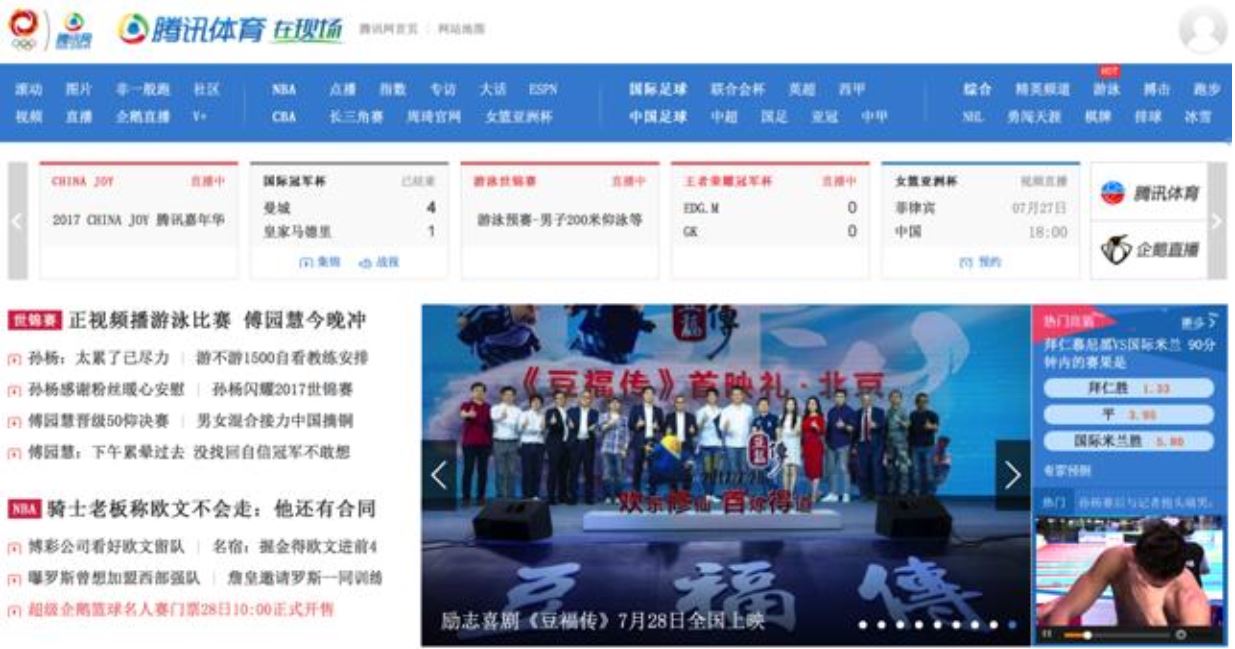 Source: sports.qq.com
Source: sports.qq.com
Metrics
Alisports streamed the 2016 Rio Olympics via Youku, Alibaba’s video streaming portal, under a licensing agreement with Chinese state-owned CCTV. As many as 380 million viewers streamed the Olympic Games through Alisports.
Outlook
Beneficiary of policy support: China’s State Council set a target that, by 2025, the sports industry will have an output value of ¥5 trillion. Alisports aims to both provide an online platform for the traditional sports industry and to digitalize and upgrade the industry.
E-sports as a major growth driver: Alisports launched the World Electronic Sports Games (WESG) in March 2016 to facilitate development of e-sports IP. Alisports aims to expand its offline eStadium (venues for e-sports tournaments) network to 10,000 in the medium term.
 Source: 2017.wesg.com
Source: 2017.wesg.com
Sports community platform: Alisports aims to create an online platform that integrates people, associations, events and sponsors.
Youku Tudou—Video Content Platform
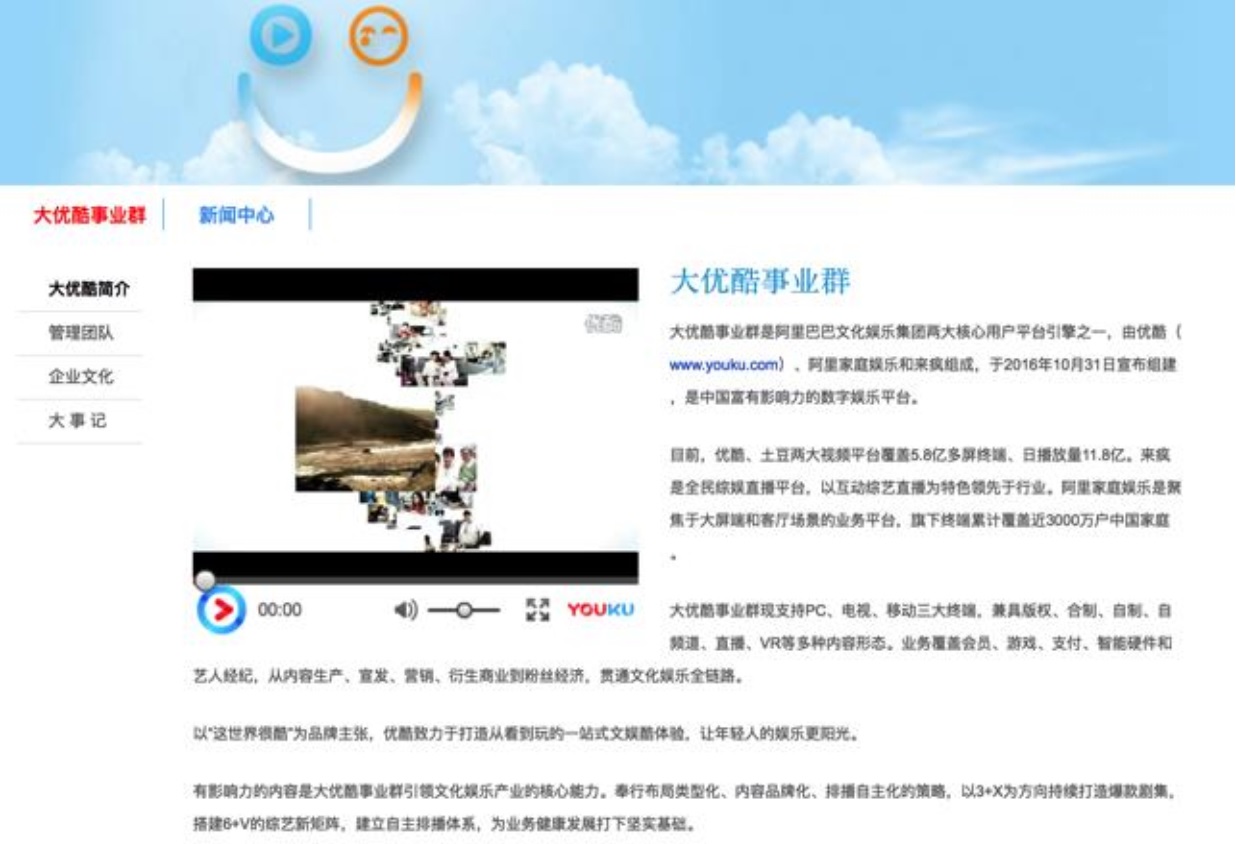 Source: c.youku.com
Source: c.youku.com
Business Overview
Youku Tudou is the leading operator of video-streaming services in China. The platform enables users to search, view and share video content across multiple devices. It was formed from the merger of Youku and Tudou in 2012, and was subsequently acquired by Alibaba in 2015. The Youku Business Division is part of Alibaba’s Digital Media & Entertainment arm.
Revenue model: Youku Tudou derives a substantial part of its revenues from online advertising and paid subscriptions. Youku Tudou also works with Alibaba’s other assets for content generation and traffic acquisition.
Strategy and Value Proposition
Gathers user analytics for better targeting: Viewers’ data on Youku is integrated into Alibaba’s e-commerce platform and helps create precise customer profiles for targeted advertising.
Content creation and partnerships: Youku Tudou has digital content partnerships with DreamWorks, Universal Pictures, Sony Pictures, Paramount Pictures and Lionsgate to stream their movies through Tmall Box Office.
A cornerstone to Alibaba’s e-commerce media ecosystem: Brands can leverage Youku Tudou for branding and marketing, and to interact with customers. Youku Tudou has created “webisodes” on Taobao to use storytelling to boost sales on Taobao and to combine video advertising and shopping.
Metrics
Youku Tudou has 30 million paying viewers, as of December 2016.
Peers
Youku Tudou’s peers are China’s leading online video platforms such as iQiYi, Sohu, Mango TV and Tencent Video.
 Source: iqiyi.com
Source: iqiyi.com
Outlook
Platform strategy: Youku Tudou will play a key role in Alibaba’s strategy of building an “e-commerce media ecosystem”, which aims to connect e-commerce platforms with media and let brands reach consumers through digital channels. Youku Tudou will become the “lifestyle channel” for Alibaba’s e-commerce platforms, together with Sina Weibo and mobile browser provider UCWeb.
Content generation: Youku Tudou will distribute and generate content to help make Alibaba a leading digital content provider in China. Alibaba’s goal is to reach 2 billion consumers with its services by 2036, by continuing to expand beyond e-commerce into entertainment, media and sports. Alibaba is a sponsor of the Olympic Games through to 2028, and the games are expected to be streamed on Youku Tudou. Youku Tudou has existing partnerships on content generation which it can leverage.
Online distribution channel for Alibaba’s media and entertainment: Youku Tudou is a key distribution channel for Alibaba’s media and entertainment unit. China’s online paid video market was valued at ¥9.6 billion in 2016, an increase of 90.8% year over year. According to a survey in 2016, 82% of Chinese prefer to watch new films on online video platforms, more than the 66% who prefer to go to cinemas.
UC Web—Mobile Internet Services
 Source: uc.cn
Source: uc.cn
Business Overview
UC Web operates UC Browser, one of the most popular mobile browsers globally. Similar to Google Chrome and Apple Safari, UC Web has both mobile and PC versions. UC Web was founded in 2004, and acquired by Alibaba in 2014, as part of the “cloud + terminal” business strategy.
UC Browser has transformed into a leading content distribution platform from its origins as a mobile browser. Its portfolio includes UC Browser (mobile browsing service), UC News (content distributor), 9Apps (Android app store) and UC Union (mobile traffic and monetization platform).
Revenue model: The primary revenue sources are from advertisements and partnerships with network operators to track analytics.
Strategy and Value Proposition
Localization strategy: UC Web has a localization strategy. It has a large user base in China, and controls more than half of the Indian and Indonesian markets. The browser supports 12 languages in order to serve its growing international user base. 9Apps, its mobile app distribution platform, was set up in 2013 and allows Android users globally to download apps.
Ecosystem partnerships: UC Web has partnerships with and provides distribution channels for companies such as Vodafone. It takes advantage of its own server networks to deliver targeted advertising and content to users.
Pairing content distribution with sophisticated data analytics: UC Web is evolving into a more intelligent platform that integrates user data analytics and multimedia content. It analyzes users’ location, age group, gender and interests to provide targeted content.
Content creation and a connector to the Alibaba media ecosystem: UC Browser connects users to the Alibaba media ecosystem of e-commerce, music and video streaming, and social networks. UC Web has content partnerships with online media portals such as Sina to extend its reach to more consumers. Media portals and publishers can create “content stores” on UC Browser to house their content. UC operates We-Media, an open platform which allows international users to publish and post content. UC also established the ¥1 billion W+ fund to reward contributors in China.
Key Metrics
UC Browser has over 252 million MAUs globally, as of September 2016 according to Quest Mobile. It is the largest mobile browser in India, with a 57% market share and over 100 million MAUs in 2016. 83% of its users are below the age of 35, and over 60% live in top-tier cities.
Peers
UC Browser’s domestic peers (mobile) include QQ browser, Baidu, 360 and Sogou.
 Source: mb.qq.com
Source: mb.qq.com
Globally, UC Browser (desktop) is ranked third with an 8% market share, behind Chrome (52%) and Safari (15%), according to Stat Counter.
Outlook
Further ramp up digital content generation: UC Web will be stepping up its content-generation efforts by partnering with more media outlets, in addition to paying users who contribute content. With the use of big data and AI, UC Web will help improve distribution of targeted content.
Overseas expansion strategy: UC Web aims to make UC We-Media the go-to platform for content consumption and creation in India and Indonesia. UC Web has set up an investment fund of Rs200 crore (over US$30 million) to strengthen user-generated content (UGC) in India and Indonesia, and news distribution through UC News. In 2017, it plans to add more than 30,000 self-publishers and bloggers to its platform, and pursue more tie-ups with Indian entertainment channels and movie makers for exclusive content releases.
Further investments in technology and platforms: UC Web is looking at investments in upstream and downstream areas in content generation and distribution in India, including those engaged in local-language content.
DingTalk—Enterprise Messaging Platform
 Source: dingtalk.com
Source: dingtalk.com
Business Overview
DingTalk is an enterprise messaging platform aimed at improving B2B communications and collaboration for small- and medium-sized enterprises (SME) and organizations in China. DingTalk was first launched in 2015 and is currently the No. 1 ranked enterprise messaging app in China.
The DingTalk mobile app provides enterprise functions such as group and personal instant messaging, video and voice conference calling, e-mail and cloud storage. It also supports internal and external business collaborations through functions such as smart report forms, attendance and approval tracking systems, etc.
Revenue model: DingTalk is currently offered free of charge.
Strategy and Value Proposition
Equipped with functions to increase the efficiency of SMEs: DingTalk was created to increase the efficiency of SMEs in China, and was designed with unique functions that make the app popular among corporate users. For example, DingTalk returns a list of staff who have or have not seen a certain announcement. These functions differentiate DingTalk from its competitors such as Enterprise WeChat and Yonyou.
Leverages Alibaba’s platform to generate value for users: DingTalk provides many value-added services to its corporate users, thanks to its synergies with the rest of Alibaba’s platforms. In March 2017, DingTalk provided ¥1 billion in subsidies to its corporates users in the form of shopping coupons on Tmall, etc. This strategy should help DingTalk increase its market share.
Endorsement from government authorities: Organizations in the public sector in China are DingTalk’s fifth-largest client category, as of March 2017, which should help to market the app effectively. The Hangzhou Economic and Information Technology Commission openly endorsed DingTalk by encouraging other departments to use the app to implement the government’s “Internet + Administration” initiative.
Peers
DingTalk’s peers in the management and collaboration application space in China include Enterprise WeChat, Yonyou and 263 Cloud.
 Source: yonyou.com
Source: yonyou.com
 Source: 263.net
Source: 263.net
Key Metrics
DingTalk has reached 3 million corporate users, as of February 2017.
 Source: Analysys
Source: Analysys
Outlook
Huge potential in China’s corporate SaaS market: The corporate software-as-a-service (SaaS) market in China is in the early stages of development and is still fragmented. We expect DingTalk to dominate China’s SaaS business services industry in the future, given the support of Alibaba’s strong data technology and cloud-computing capability.
Expansion into other verticals: DingTalk will likely expand further to other applications in order to bring more value to enterprise users.
Revenue opportunities for DingTalk: We expect DingTalk’s future revenue model to either be based on value-added services or a subscription model similar to other SaaS apps in the US.
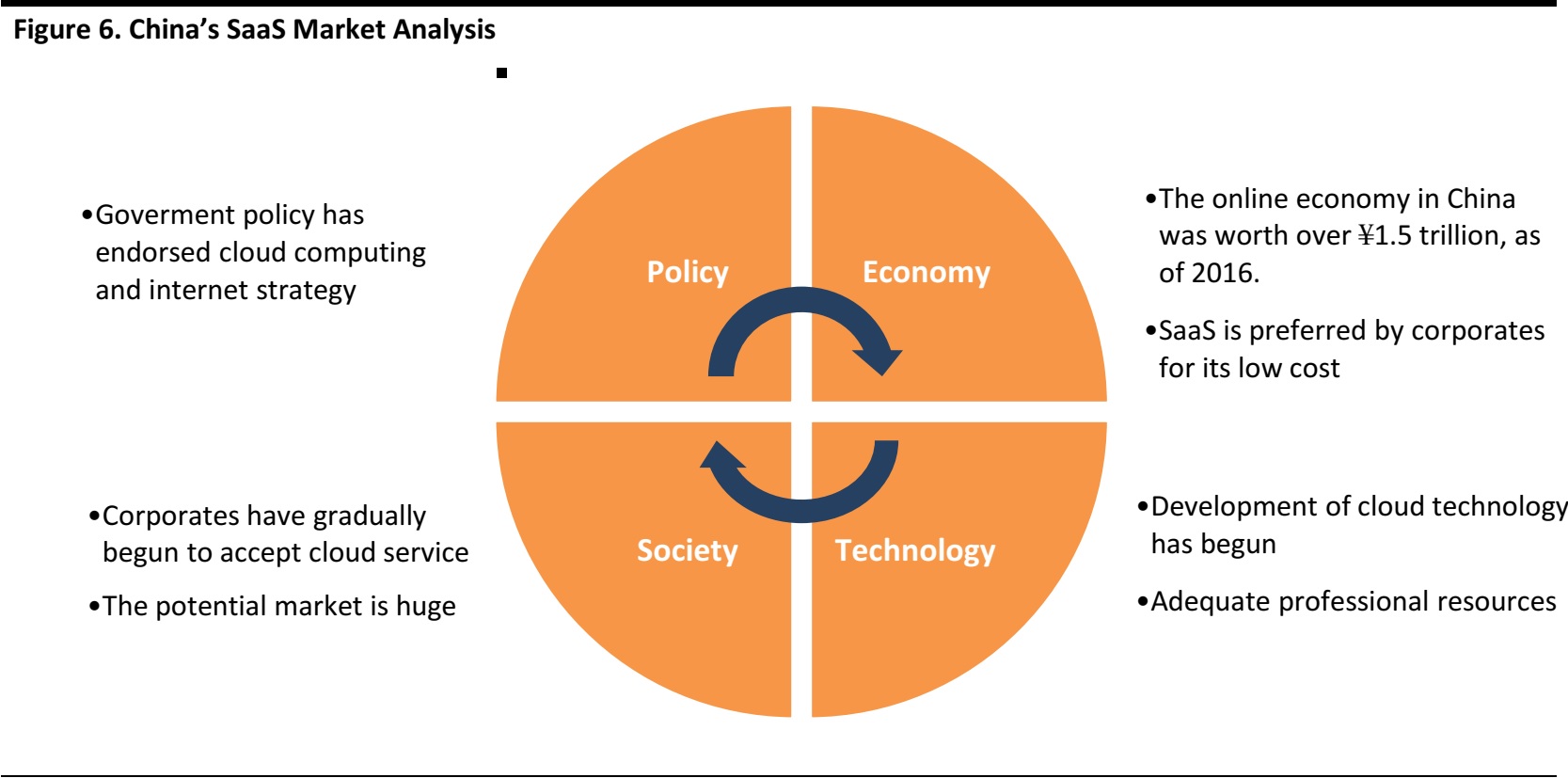 Source: iResearch
Source: iResearch
YunOS—Cloud-Based Operating System
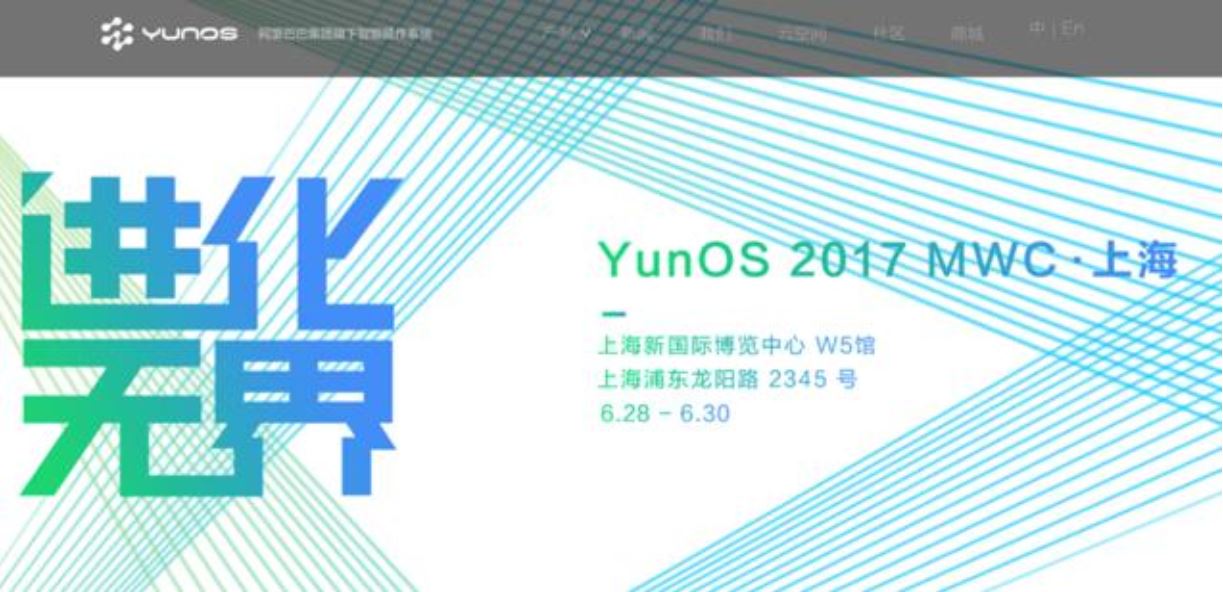 Source: yunos.com
Source: yunos.com
Business Overview
YunOS (also called Aliyun OS) is an Internet of Things (IoT) operating system that brings cloud functionality to IoT and mobile devices. It was first introduced by AliCloud in 2011.
YunOS was built to work in a cloud environment: devices can synchronize data from the cloud and users can access applications without having to download to their devices.
Revenue model: Alibaba develops and sells cloud-based services on YunOS. It does not charge licensing fees to hardware manufacturers who install YunOS on their products. Instead, Alibaba shares in the revenues derived from these products and its cloud services. The more popular a service becomes, the faster the system’s user base expands and the higher the revenue share for YunOS.
Strategy and Value Proposition
Highly compatible and IoT focused: Compared to other domestic operating systems, YunOS emphasizes compatibility and the concept of “connecting all kinds of devices.” YunOS can be adopted in smartphones, smart cars, wearables, smart-home appliances and other smart devices. YunOS is an open source operating system that allows third-party developers to build their own services.
 Source: yunos.com
Source: yunos.com
Critical mass in China: YunOS is the second-largest operating system for smartphones in China and is ahead of Apple iOS. YunOS-installed smartphones comprised an estimated market share of 14% of total shipments in China, as of the end of 2016.
Extensive use cases: YunOS is used to enhance consumers’ shopping experience both at physical stores and online. For example, the YunOS-powered virtual mirror with face-recognition algorithm allows users to see the effects of different cosmetics using software.
Key Metrics
YunOS has over 70 million mobile phone users and over 100 million total users across all platforms, as of the end of May 2016.
An estimated 100 million YunOS-powered smartphones were shipped in 2016, according to Strategy Analytics.
YunOS is the second-most-popular smartphone OS in China, with a 14% market share, as of the end of 2016. Android has over an 80% market share, while iOS has a 6% market share.
Peers
YunOS is ahead of its domestic peers in terms of IoT operating system. Other domestic peers include:
Tencent Operating System (TOS+) is an OS for connected devices such as TVs and wearables.
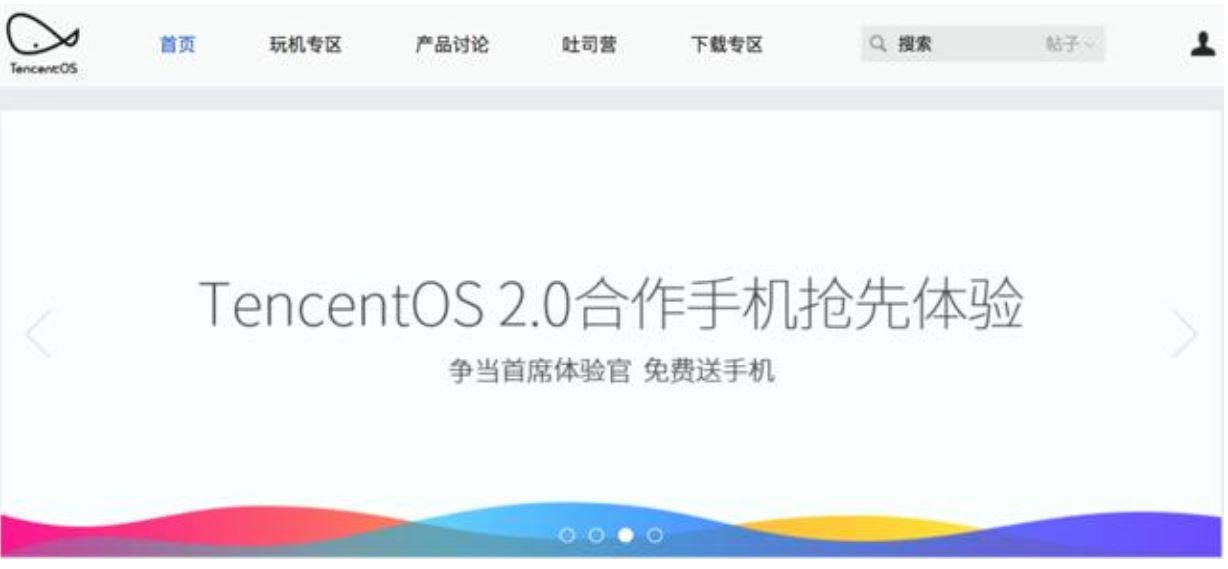 Source: bbs.tos.cn
Source: bbs.tos.cn
Freeme OS, by Droi Technology, is an Android-based OS for both smartphones and wearable devices, launched in 2012. The OS currently has 95 million users globally.
MIUI is an Android-based smartphone and tablet computer OS developed by Xiaomi. It mainly supports Xiaomi products, and is also open for other brands. The OS currently has over 200 million users.
 Source: miui.com
Source: miui.com
Baidu Yi, the Android-based OS developed by Baidu, was suspended in 2015.
EUI is an OS developed by LeTV for smartphones, TVs, automobiles and smart devices.
Outlook
Alibaba will likely continue to develop an integrated IoT operating system to generate additional revenue streams.
The goal is to become the industry standard: Alibaba’s goal is for YunOS to become the industry standard for the global smart device industry as well as the ‘go-to’ operating system for China’s smart device industry, according to a YunOS product director.
Huge potential for IoT in China: China’s IoT market is expected to reach US$121.5 billion by 2022, representing a compound annual growth rate (CAGR) of 41.1% between 2016 and 2022. The primary growth drivers are increasing industrial automation, mainstream adoption of cloud computing and increasing mobile internet penetration.
Expansion into different product verticals through partnerships: Alibaba has been working with international hardware manufacturers such as HP and Intel on “YunOS Book” tablets. It is cooperating with Sharp, Haier, Lenovo and Skyworth to produce smart TVs with YunOS installed. Alibaba’s RX5 SUV, an “Internet Car” with built-in YunOS with SAIC Motor, was released in June 2016. The smart car is able to communicate with other vehicles, and businesses and can find parking spaces, locate gas stations and pay for services with Alipay.
Overseas expansion: The next stage of growth for YunOS-powered mobile devices is urban China and overseas. The global OS market is led by Apple and Google. Currently, YunOS is mainly installed on lower-end smartphones. Any push to expand overseas will require strong technical features and increased R&D deployment.
AutoNavi—Digital Map, Navigation and Location-Based Services
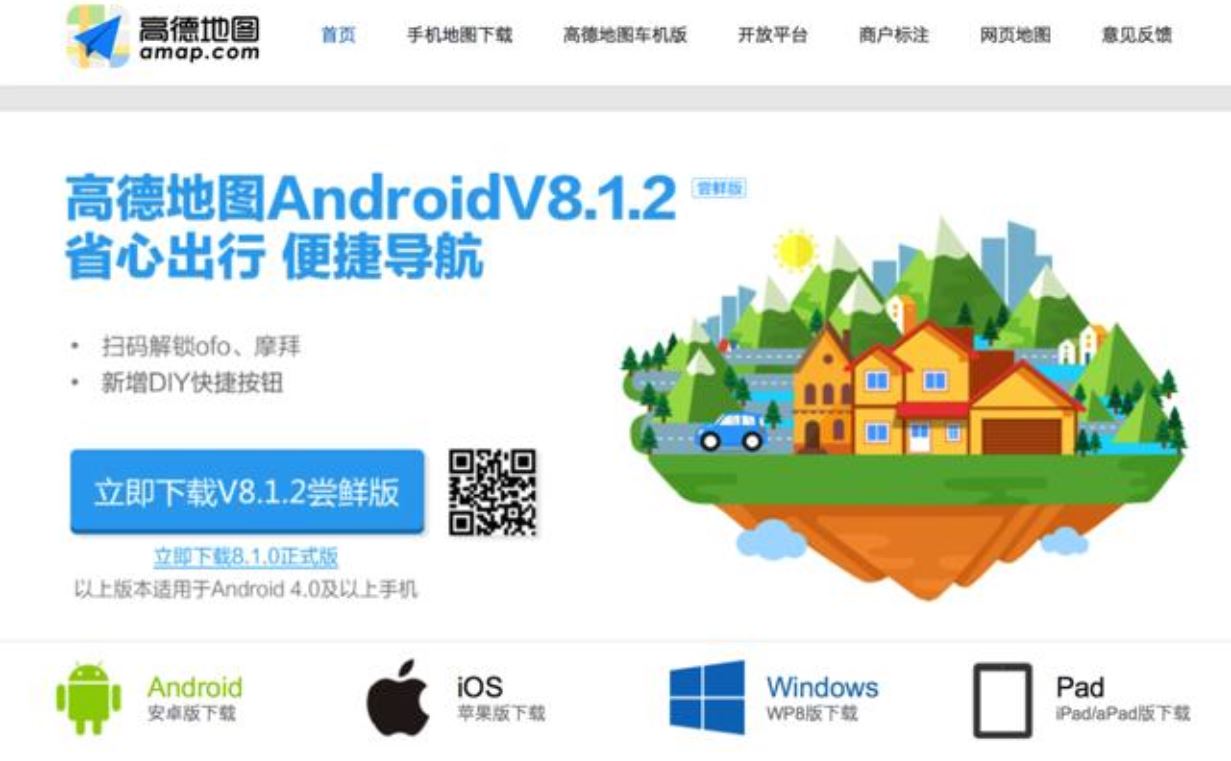 Source: autonavi.com
Source: autonavi.com
Business Overview
AutoNavi is a digital map and navigation solutions provider in China that was established in 2001 and acquired by Alibaba in 2014. AutoNavi is an operating partner of Google Map, Bing Map and 360 Map in the Chinese market, and the data provider for Apple Maps. The AutoNavi system supports functions such as AR visual navigation, 3D landscape, cloud sync, real-time traffic conditions, offline navigation, etc.
Revenue model: The basic navigation function is free of charge. The navigation app mainly generates revenue from value-added services:
- Commission earned from LBS services: The app provides location-based-services (LBS) to service providers such as car-hailing company Didi Chuxing. AutoNavi earns commissions from connecting service providers with users.
- Advertising income: AutoNavi auctions advertisement spots inside its app to businesses.
Strategy and Value Proposition
Increased accuracy of LBS through user-generated content: AutoNavi captures users’ driving patterns in real-time, powered by big data and cloud computing. AutoNavi also collaborates with police and transport administration offices to capture data relating to traffic incidents, which increases the accuracy of the reporting of real-time road conditions to over 90%. AutoNavi collects users’ data to provide personalized offline services and recommend nearby restaurants, gas stations, entertainment facilities, etc. AutoNavi has had its core system on AliCloud since January 2016.
Constantly enhance capabilities to create value for users: AutoNavi has extended the modes of transport available on the app to five after including trains and cycling. It is also customizing solutions based on each user’s preference and spending patterns, and has been active in partnering with other companies to extend its business scope. AutoNavi will generate maps for automated driving projects under partnerships with German automobile supplier Bosch and Chinese-language internet search provider Baidu.
Increase entertainment value with celebrity voice navigation: AutoNavi provides voice prompted turn-by-turn voice navigation that is recorded by celebrities, including Taiwanese actress, Lin Chi-ling and Chinese comedian Guo Degang. AutoNavi saw a 230% increase in first-time users when this function was released.
Peers
Mobile navigation: AutoNavi and Baidu Map are the top-two navigation apps that dominate the domestic market.
 Source: Baidu Map IOS App
Source: Baidu Map IOS App
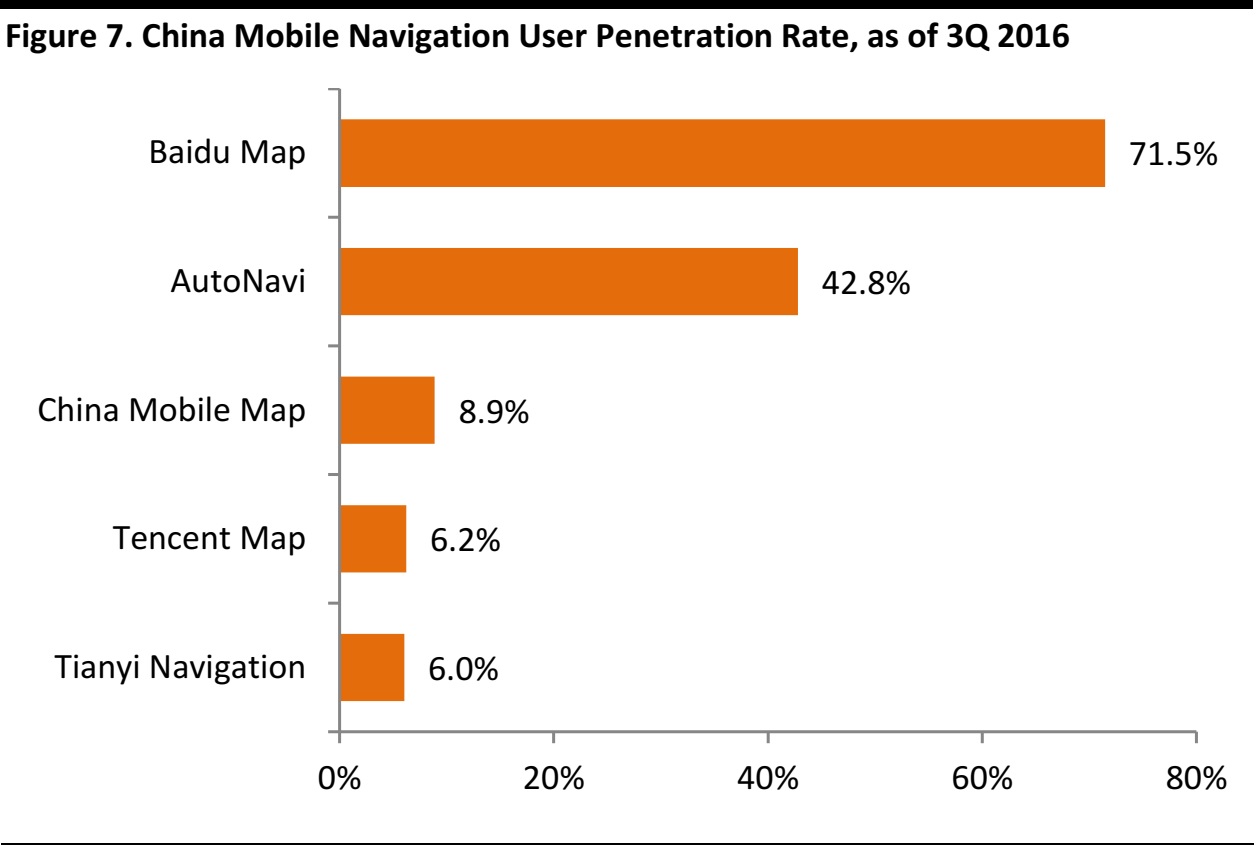 Source: Analysys
Source: Analysys
Metrics
AutoNavi had 29 million monthly active users, as of 2016.
Outlook
Dominance in the domestic market: We believe AutoNavi will continue to lead in the domestic mapping market, given its superior service quality and real-time traffic information powered by big data.
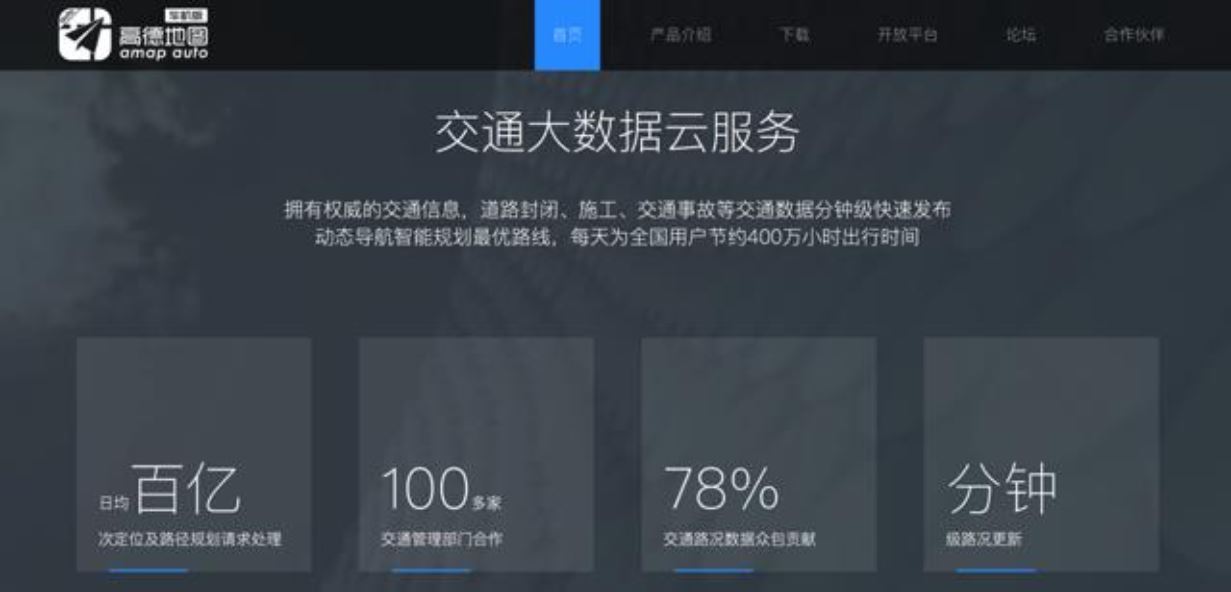 Source: auto.amap.com
Source: auto.amap.com
Future plans: AutoNavi is developing a model to predict future traffic conditions. Beyond navigation and traffic data, future areas of focus—known as its “Four Vehicles Strategy”—include internet of vehicles, auto-drive maps, traffic big data and open platform service. We expect AutoNavi to pursue further strategic partnership opportunities.
Policy support for China’s autonomous vehicle market: China aims to have autonomous vehicles on the road by 2021. The policy opens a new opportunity for AutoNavi since a traffic database and complete navigation functions are key elements of an autonomous vehicle. The company has already entered into a partnership with Germany’s Robert Bosch on autonomous vehicle development. We expect further strategies to be implemented to increase the company’s presence in the autonomous vehicle market.
Alibaba Health—Online Healthcare Platform
 Source: alihealth.cn
Source: alihealth.cn
Business Overview
Alibaba Health Information Technology, or Ali Health, is the healthcare arm of Alibaba that was formed from its acquisition of Citic 21CN in 2014. The company’s objective is to use technical capabilities to improve healthcare services. Ali Health has an online health insurance joint venture to build an online community for the Chinese healthcare market. The company trades on the Hong Kong Stock Exchange under the ticker 241 HK.
Ali Health’s main revenue stream used to come from the operation of the China Drug Administration Online System, an online drug tracking and pharmacy online system that lets users track drug production and distribution information. However, the system was subsequently suspended in 2016.
Strategy and Value Proposition
Create value across the entire medical industry chain: Alibaba aims to connect patients, pharmacies and doctors by bringing hospital services online and to build an internet pharmacy through Ali Health. Ali Health has introduced the Ali Health mobile app to provide online health consultation services by healthcare professionals.
Affordable healthcare accessible to all: Ali Health’s mission is to make “good health achievable at the fingertips of all” and its vision is to provide “fair, affordable and accessible medical and healthcare services to 1 billion people.” In pursuit of this mission, Ali Health has strived to develop pharmaceutical e-commerce, intelligent medicine and product-tracking system services.
Peers
Baidu Doctor is an online platform that lets patients book medical appointments with doctors in local hospitals. Baidu Doctor has an AI-powered chatbot to send responses on behalf of doctors after the doctors have verified the information.
Tencent Doctor connects doctors and patients through its instant messaging app WeChat. Registered doctors and medical organizations can provide paid medical consultation services through the platform.
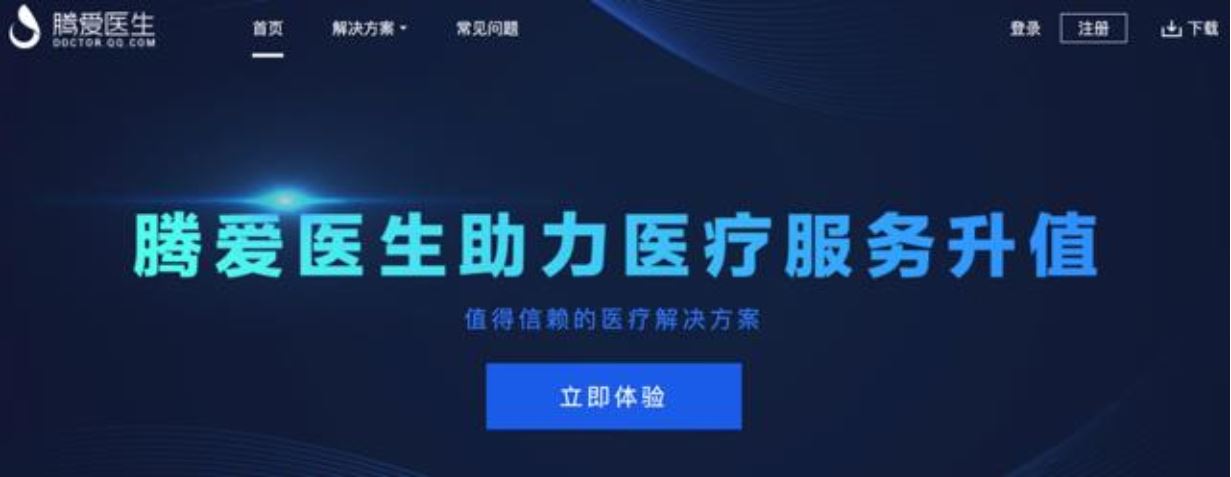 Source: doctor.qq.com
Source: doctor.qq.com
Key Metrics
As of March 2017, more than 5,000 enterprises from the drug, food and nutritional supplement industries had signed up to join Ali Health’s Ma Shang Fang Xin platform, which offers product-tracking services for quality assurance. More than half of the pharmaceutical manufacturers in China have signed up.
Outlook
Ali Health will need to find a sustainable business model and work with different stakeholders to align with policy initiatives.
China’s promising digital health industry: Over the long term, Chinese authorities will likely support the online healthcare market to alleviate the burden on the public system. Pharmaceutical e-commerce in China is at a nascent stage of development, comprising approximately 3% of pharmaceutical sales in the country, with huge potential for further growth.
Regulatory support: Ali Health will need to find a sustainable business model and work with different stakeholders to align with policy initiatives. The Chinese government has implemented a number of healthcare reform initiatives to encourage tiered medical consultation and treatment, and for doctors to practice at multiple locations.
Koubei—O2O Local Services
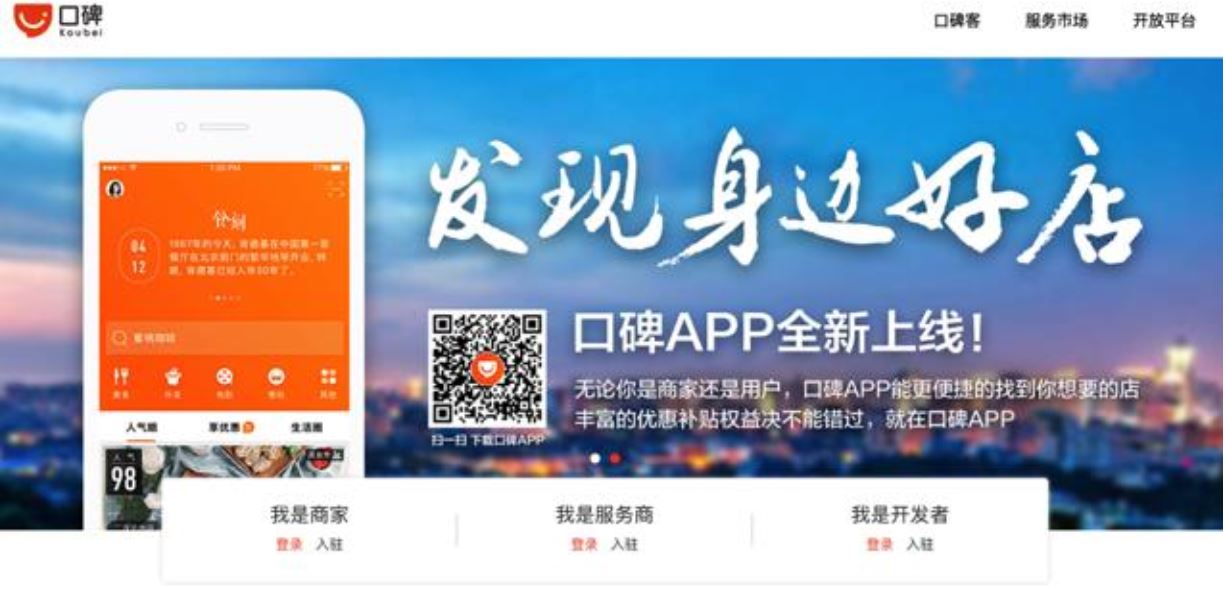 Source: koubei.com
Source: koubei.com
Business Overview
Koubei is an open platform for customers and merchants, and a search engine that provides information on local services such as restaurants, food delivery, movie ticketing, shopping, travelling, etc. Koubei was formed from a joint venture between Alibaba and Ant Financial Services in 2015 and is integrated within Alipay.
Revenue model: Koubei does not charge service fees to merchants on its platform. It takes part of the commission that third-party marketers receive for successfully promoting a merchant’s services to consumers.
Strategy and Value Proposition
Empowers both online and offline merchants: Koubei empowers merchants with payment, marketing, customer service and data analytics functions to handle their day-to-day operations. It helps local merchants retain their existing clients and attract new customers. For example, Koubei offers deals and coupons to encourage users to spend at physical stores.
Leverages Alibaba’s ecosystem: Various functions within Alibaba help drive traffic to Koubei, including the Taobao mobile app, Alipay, AutoNavi, Weibo and UC Browser. For example, Koubei uses the AutoNavi map technology to recommend local merchants such as restaurants, supermarkets and convenience stores to users. Alipay serves as a channel for payment, loyalty, promotions and data collection from users.
Enlists third-party marketers to onboard merchants: Koubei recruits marketers through the “Koubeike” program to onboard local merchants and restaurants to the Koubei platform. These interested third-party marketers earn a cash commission and coupons, and Koubei benefits from a growing merchant base
Array of technologies embedded in Koubei: Koubei helps local merchants create virtual stores for consumers to browse through merchandise, pay and receive discounts. Consumers can access the virtual store by scanning the merchant’s QR code. The Koubei mobile app also integrates AR technology in order to let users easily discover local services in their vicinity.
Peers
Dianping (大众点评
) is a local services app backed by Tencent that currently dominates China’s O2O industry.
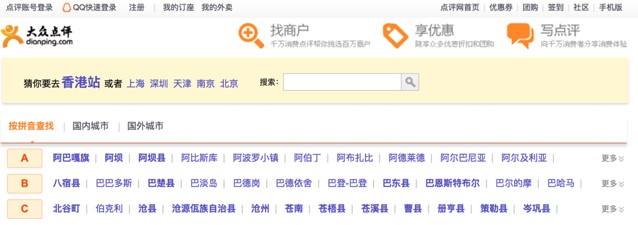 Source: dianping.com
Source: dianping.com
Ele.me is a Food delivery service backed by Alibaba and Tencent that aims to digitalize the catering industry
Key Metrics
Koubei has 1.5 million third-party service providers, handling an average of 15 million transactions daily, and has a presence in 120 cities.
Koubei generated ¥73.1 billion (US$10.5 billion) in payment volume transacted through Alipay during the quarter ending December 2016, representing a 52% increase over the prior quarter.
Outlook
Competitive domestic O2O market: Koubei faces competition from the market leader Dianping in the domestic market. According to Trustdata, the total turnover of the four largest China’s local life service O2O brands was ¥550 trillion. Meituan-Dianping accounted for 44%, followed by Koubei’s 31%. Koubei will likely need to spend on traffic acquisition in order to win market share.
Overseas expansion: Online-to-offline e-commerce platform Koubei helped boost sales at overseas physical stores during the Double 12 festival in 2016. Over 70,000 physical retailers in 16 countries—including duty-free shops, supermarkets and department stores—participated in the festival through Koubei.
Supports the group’s New Retail strategy: Koubei will play an important role in implementing Alibaba’s New Retail strategy as the platform directs online traffic offline, boosting offline store sales. Users can search for local merchants using Koubei and then visit the stores to take advantage of promotions.
Cainiao Network—Affiliated Logistics
 Source: global.cainiao.com
Source: global.cainiao.com
Business Overview
Cainiao Network is an asset-light, logistics data platform that drives efficiency by connecting e-commerce companies with logistics companies to provide fulfilment on a large scale. Cainiao’s platform spans delivery, warehouse, pick-up, and rural and cross-border logistics. Cainiao’s logistics platform incorporates over 20 logistics firms globally and leverages big-data technology. Cainiao Network was established in 2013 and is a 47%-owned logistics affiliate of Alibaba Group.
Revenue model: Cainiao Network generates revenue from business on e-commerce platforms and logistics companies.
- E-commerce business: Cainiao Network charges services fees for providing storage and distribution, cross-border transportation and a comprehensive logistics service.
- Logistics companies: Cainiao Network charges commissions to logistics companies for providing logistics solutions based on its big-data system and logistics cloud.
Strategy and Value Proposition
Aligned to the group’s holistic approach to commerce: Cainiao Network fulfils the logistics aspect of Alibaba’s holistic and technology-driven approach to commerce for its stakeholders. In addition, Alibaba is able to add a revenue stream from its third-party logistics networks by charging service fees.
Advantages of a platform approach: Cainiao’s data-driven logistics platform has several advantages over the traditional logistics model, as it integrates existing logistics resources and empowers partners with increased logistics efficiency. The platform approach gives stakeholders a degree of control without having to develop their own logistics operations in-house.
Speed: Cainiao Network’s goal is to deliver anywhere in China within 24 hours, and worldwide within 72 hours. The platform adopts standardized e-shipping labels to reduce order-processing time and a smart-routing service based on the analysis of real-time aggregated industry delivery data.
Value-added services: The platform enables merchants to optimize demand volatility and see real-time information on delivery options, prices and time. Alibaba provides data intelligence and forecasts parcel demand volatility by analyzing consumer transaction data. Consumers are able to track deliveries on their mobile Taobao app, which fulfils their demand for convenience.
Peers
Cainiao Network’s domestic peers include:
Self-owned logistics network: JD Logistics, Suning Logistics, Amazon.cn
 Source: wuliu.suning.com
Source: wuliu.suning.com
Network of logistics providers: Pinjun Express
Key Metrics
Cainiao’s nationwide fulfilment network has seven regional hubs to serve delivery coverage of over 2,700 counties and districts, as of March 2017. For its global fulfilment network, it covers 224 countries and regions with over 100 overseas warehouses and over 60 cross-border partners, as of March 2017.
Outlook
Rising domestic logistics demand: The rise of e-commerce has driven the growth of China’s logistics industry, and brought with it operational challenges. In China, an average of 57 million packages were delivered each day in 2015 (vs the US average of 35 million), which is expected to increase to 145 million by 2020. The timing of promotional activities such as Singles’ Day causes a spike in logistics demand and burdens logistics partners.
I
ncreasing efficiency and reducing costs: By building an intelligent and sharing logistics model, Cainiao Network aims to lower the cost of logistics as a percentage of GDP to 5% in the future, from the current level of 16%. Alibaba plans to use technology to further reduce inefficiency, for example, through the adoption of cloud services.
Ant Financial—Online Financial Services Provider
 Source: antfin.com
Source: antfin.com
Business Overview
Ant Financial is an online financial services provider and an affiliate company of Alibaba. It was renamed from Alipay in 2014. Its vision is to leverage the power of the Internet and big data to provide an ecosystem of inclusive financial services to SMEs and individuals. To this end, Ant Financial operates five primary lines of business:
- Payment products: Alipay
- Wealth-management products: Yu’ebao, Zhaocaibao.
- Financing: Ant Check Later, Ant Micro Loan, MY bank
- Insurance
- Third-party credit rating: Sesame Credit
Ant Financial has also partnered with leading financial institutions including Bank of China, China Construction Bank, Agricultural Bank of China and the Industrial and Commercial Bank of China. It has also partnered with O2O local services to provide payment services.
Revenue Model: The primary sources of revenue for Ant Financial include:
- Commissions and interest received from Alipay
- Service fees from wealth-management products
- Interest income from individual and corporate loans
- Premium income from insurance products
Strategy and Value Proposition
Network effects and a huge user base: Ant Financial benefits from a huge user base which serves as the foundation of its big data, and provides an edge in developing and launching new services. There are 520 million registered Alipay users, as of March 2017.
Leading breadth and scale across the financial services spectrum: Ant Financial possesses state-of-the-art technologies to power its financial products and continuously improve users’ experience. For example, the MYbank loan system automates loan decisions; Zhema Credit creates personal credit scores based on an individual’s profile gathered by big data; and Ant Financial Cloud is an open platform based on Alibaba Cloud infrastructure and customized for financial purposes.
Focused on serving individuals and small business: Ant Financial is focused on providing equitable access to financial services for those individuals that are underserved by traditional financial institutions. This strategy of inclusive finance enables Ant Financial to gain traction among its target groups quickly.
Tailwind for mobile payment provider as China goes cashless: Ant Financial is well positioned to benefit from China’s entry into the cashless era. Not only does Alipay have the largest share in the mobile payments market, its goal is to bring China into a cashless era within five years with the establishment of a cashless alliance. Alipay has established partnerships with retailers such as airports, restaurants, supermarkets and transport to support mobile payment with the aim to penetrate every facet of companies’ activities.
Peers
Ant Financial’s peers include:
Domestic: JD Finance, Tencent’s WeChat Pay, commercial banks
 Source: pay.weixin.qq.com
Source: pay.weixin.qq.com
Overseas: Paypal
 Source: paypal.com
Source: paypal.com
Key Metrics
Ant Financial served 520 million annual active users and its strategic local partners served 112 million annual active users globally, as of March 2017.
Outlook
Branded as a techfin company: Ant Financial plans to focus on building a techfin platform to connect consumers and small businesses with financial institutions. Ant Financial is driving innovations such as the shift from passwords to biometrics ID in order to make payments more convenient and secure, and the use of blockchains in charitable donations and insurance to build trust.
Continue to strengthen rural finance: Ant Financial continues to push for expansion in rural areas as part of its inclusive finance strategy. The company provides loans for farmers and cooperates with agriculture and stockbreeding companies. Ant Financial will also introduce rural supply-chain finance solutions, O2O local services and a digitalized loan platform to its rural finance strategy.
Globalization: Ant Financial aims to increase the proportion of its overseas users to 50% within four years and its entire global user base to 2 billion within nine years. The company is actively increasing its global presence through overseas investments and partnerships.
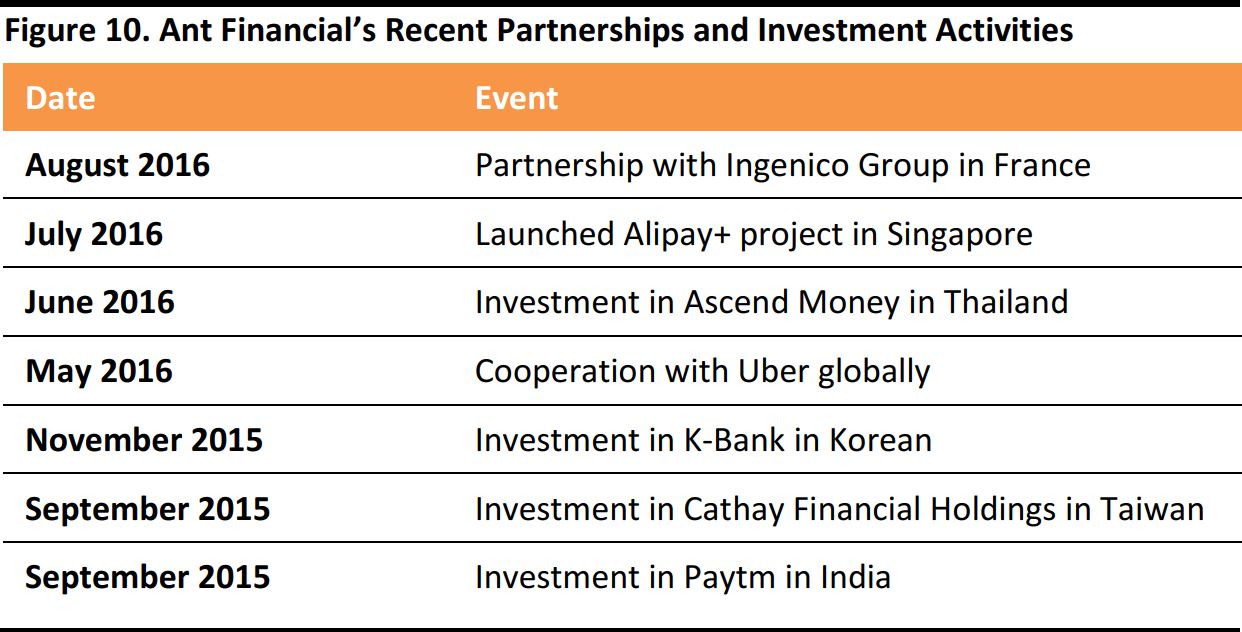 Source: 360doc/FGRT
Source: 360doc/FGRT
Alipay—Third-Party Online Payment
 Source: alipay.com
Source: alipay.com
Business Overview
Alipay is a leading third-party online payment app developed by Ant Financial, an Alibaba-affiliated company. Founded in 2004, Alipay provides payment and escrow services for transactions on Alibaba platforms. Alipay has since expanded to other verticals such as utility bill payment, online shopping and financial products, including personal loans, insurance, investment funds, etc. Alipay leads China’s third-party payment market with a 53.7% share, in the first quarter of 2017.
Revenue model: Alipay has three primary sources of revenue:
- Interest income: Interest income can be earned while proceeds of transactions are temporarily deposited in Alipay.
- Commission: Alipay charges a commission to merchants.
- Advertisement fees: Alipay also rents advertising space on its app.
Strategy and Value Proposition
Goal to provide inclusive financial services: Alipay aims to expand access to financial services to the unbanked and underbanked by making traditional banking services accessible to all Chinese and international citizens. To do this, Alipay has developed a range of services on its platform, starting with an escrow function that instills trust between consumers and merchants and rural finance.
A single platform that aggregates multiple functionalities: Initially designed to facilitate trades on Alibaba’s marketplaces, Alipay now aggregates a range of services on its platform—including online payment processing, digital wallets, investment products, daily services for local amenities and money transfers—into a single platform.
 Source: Alipay company website
Source: Alipay company website
Leveraging big data technology: Alipay has been penetrating into many consumption scenarios and touch points to generate a more comprehensive profile of its customers. Given the huge volume of transactions it processes, Alipay can fill the gap where a mature system for assessing consumer credit risk is lacking in China. Consumption patterns captured by Alipay translate into Sesame Credit scores to determine users’ creditworthiness.
An important role in New Retail: Alipay will play a key role in directing traffic from online to offline and gaining access to user analytics. Alipay demonstrated its prowess in supporting physical merchants during the Double 12 shopping festival in 2016. Alipay also built AR technology into its platform for the Spring Festival 2017. It developed a new AR game, which, similar to the successful Pokémon Go game, allowed users to hunt and open e-hongbao (digital red packets), which gave them access to prizes, monetary rewards or exclusive content. Alipay has also been integrated as a payment option at the department stores of Bailian Group and Intime Retail, both of which are strategic partners of Alibaba.
Global expansion: Alipay is expanding overseas through acquisitions and organic growth. The group acquired Singapore-based payment service helloPay in 2017 to facilitate its e-commerce business Lazada in South-East Asia, and is in the process of acquiring US-based MoneyGram, the world’s leading money transfer service, to further increase its presence in the US and in remittance. The deal is expected to close in the second half of 2017. Alipay has exposure to the Chinese outbound travel market through its partnerships with overseas merchants, such as Harrods, Selfridges, DFS, Macy’s, Nordstrom, etc.
Partnerships with foreign brands online: Alipay has formed partnerships with overseas merchants, including fashion and luxury e-commerce sites, to serve Chinese consumers. The ePass program, established by Alibaba in 2014, makes it easier for Chinese shoppers to buy foreign goods, pay through Alipay and ship using Alibaba’s global logistics network.
Peers
Alipay’s domestic peers include:
- Tenpay (财富通): Tencent, whose payment infrastructure supports WeChat Pay, is the second-largest player after Alipay. As at the end of 1Q17, Alipay has a 53.7% market share and WeChat Pay has a 39.5% market share.
 Source: tenpay.com
Source: tenpay.com
- China UnionPay: A major bank card scheme in China. It is the third-largest payment network globally after Visa and MasterCard, in terms of value of transactions processed.
 Source: cn.unionpay.com
Source: cn.unionpay.com
Alipay’s overseas peers include:
- Apple Pay: Apple’s mobile payment and digital wallet
 Source: apple.com/apple-pay
Source: apple.com/apple-pay
Metrics
Alipay has 520 million active users and settled 200 million transactions daily, as of March 2017. In 2017, 72% of GMV on Alibaba’s China retail marketplaces was settled through Alipay.
Outlook
The future growth of Alipay will likely be driven by overseas expansion and cross-industry collaboration, given the high penetration of mobile wallets in China. Some 65% of all mobile users in China use their phones as wallets, the highest penetration globally, according to the Ministry of Industry and Information Technology.
Overseas expansion: Alipay aims to expand its global presence to allow Chinese tourists to spend money abroad by using Alipay to pay for purchases. Alipay’s overseas partners include duty-free retail, payment processors and luxury department stores. Alipay will play an important role in Alibaba’s goal to help 1 million US small businesses enter the Chinese market. There are currently 7,000 US businesses on Alibaba’s platforms. Alipay raised US$4.5 billion in April 2016 to expand its global presence tenfold, by partnering with 1 million offline merchants over the next three years.
Growth through cross-industry partnerships and investments: We expect Alipay to continue to grow its payments ecosystem through partnerships and investments in companies with which it has synergies.
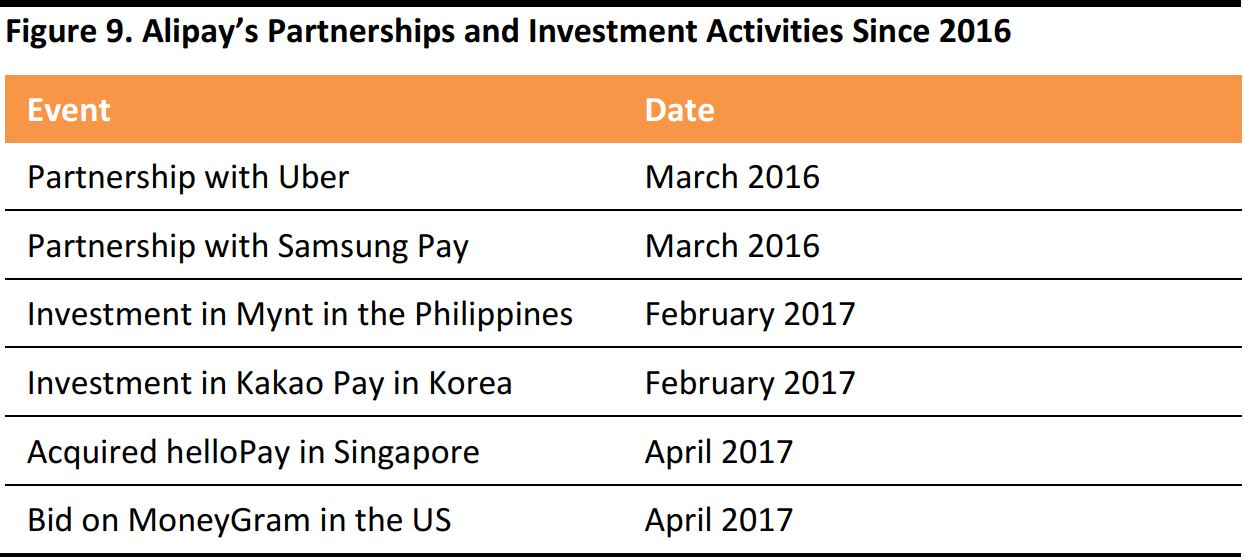 Source: FGRT
Source: FGRT
Regulatory barriers: Alipay will inevitably encounter foreign regulations as it expands overseas. These regulatory regimes may be complex and require extensive time and resources to ensure compliance with local regulations.
Alibaba Cloud—Provider of Cloud-Computing Services to Businesses and Entrepreneurs
 Source: cn.aliyun.com
Source: cn.aliyun.com
Business Overview
Alibaba Cloud (AliCloud) is engaged in the development of platforms for cloud computing and data management. AliCloud offers a complete suite of cloud and big-data services, as well as businesses solutions in gaming, e-commerce, IoT, media and other industries.
Revenue model: AliCloud charges different levels of pricing for its products, and the price increases with the size of the capacity package. Prepaid and pay-as-you-go payment methods are available: prepaid caters to long-term users and pay-as-you-go charges users for the functions and duration of usage, and offers more flexibility.
Strategy and Value Proposition
Leader in the domestic IaaS market: AliCloud is the No. 1 public infrastructure as a service (IaaS) provider in China, with a market share of over 50%. The company has continuously made technological breakthroughs in providing ever-higher computing capacity. The MIT Technology Review recognized Alibaba Group’s “Pay-With-Your-Face” system and reinforcement learning technique in its 2017 top technologies list.
Creating value by supporting other business units: Alibaba Group’s various business units benefit from the development of its cloud-computing arm AliCloud. AliCloud powers and increases the efficiency of e-commerce, media, marketing and other operations. For example, AliCloud helped process huge sales volumes on its annual shopping festival Singles’ Day in 2016, which recorded 175,000 transactions per second at its peak.
Democratizing cloud services for startup ecosystems and public services: AliCloud has been making AI technology more accessible to businesses and organizations through its machine-learning platform. Traditional businesses can make use of AliCloud’s ET program—including Industrial Brain, Medical Brain and City Brain—to solve complex problems across different industries. AliCloud’s global startup program, Create@Alibaba Cloud, supports startups with its suite of cloud-computing infrastructure services. In 2017, the program will be expanded to cover Mainland China and 12 overseas markets and regions.
Global expansion: The number of AliCloud data centers globally increased to 14, after the opening of four new data centers in 2016—in Dubai, Europe, Australia and Japan—as a strategic move to expand globally. It is planning to build new data centers in Malaysia, India and Indonesia this year. The company has formed partnerships with foreign enterprises, such as establishing a joint venture with Softbank in Japan. Alibaba also entered into a 12-year partnership with the International Olympic Committee to provide cloud services to Olympic events, with the goal to improve the efficiency of the Olympic Games through big-data analytics.
Peers
IaaS Cloud: Alibaba Cloud is the largest cloud infrastructure services provider in China, and is currently ranked fifth in the global cloud market in terms of cloud sales, according to market research firm Canalys.
By 2020, Alibaba Cloud is forecast to take 7.8% of the global public cloud market, while Amazon Web Services, Microsoft Azure, IBM and Alphabet Inc (Google Cloud) are expected to account for 69.1%.
 Source: azure.microsoft.com
Source: azure.microsoft.com
Metrics
AliCloud has over 874,000 paying cloud customers, as of March 2017, and a total of 2.8 million users.
In fiscal year 2017, AliCloud generated ¥6.7 billion in revenues, accounting for 4% of the group’s total revenues.
Outlook
Seek further domestic and overseas growth: In order to compete effectively with Amazon Web Services and Microsoft Azure in the global market, we expect AliCloud to continue to strengthen its global expansion and localization efforts. It introduced a program called AliLaunch, which encourages third-party tech companies to sell software based on the AliCloud infrastructure. The aim of the program is to discover more revenue opportunities.
Further extend cloud coverage to more verticals and industries: We expect AliCloud to further expand its coverage to more industries with new products such as ET Industrial, City and Medical Brains.
Alimama—Data-Driven Marketing Technology Platform
 Source: alimama.com
Source: alimama.com
Business Overview
Launched in 2007, Alimama is a platform that provides merchants and brands with online marketing services on Alibaba’s marketplaces and through third-party media outlets.
Alimama’s various marketing products include:
- Taobao Ad Network and Exchange (TANX): A real-time online marketing exchange that automates the transaction of advertising inventory.
 Source: tanx.com
Source: tanx.com
- Data management platform (DMF): A platform that allows marketers to identify targeted audience groups through big data by improving digital advertising efficiency.
- Taobao Zhitongche (淘宝直通车): A marketing service that returns personalized product recommendations on Alibaba’s marketplaces—Taobao, Tmall and Juhuasuan—from key word searches to attract targeted groups.
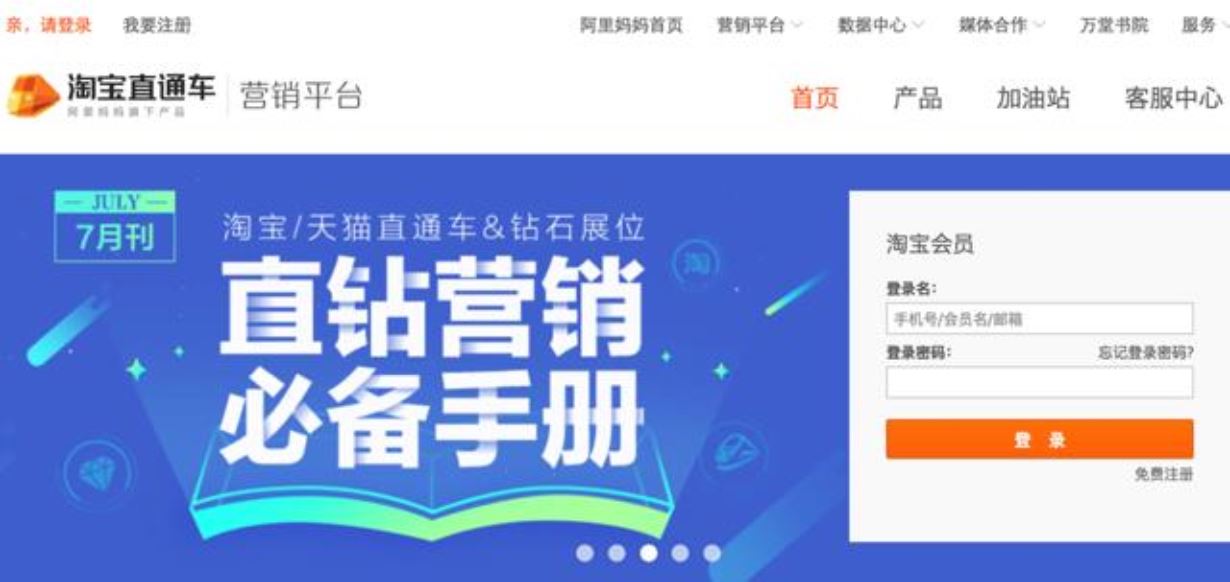 Source: zhitongche.taobao.com
Source: zhitongche.taobao.com
- Diamond (智钻): A marketing platform that displays customized banners and visual advertisements across Alibaba’s platforms. The coverage of the marketing platform reaches over 80% of the entire domestic online shopping customer base.
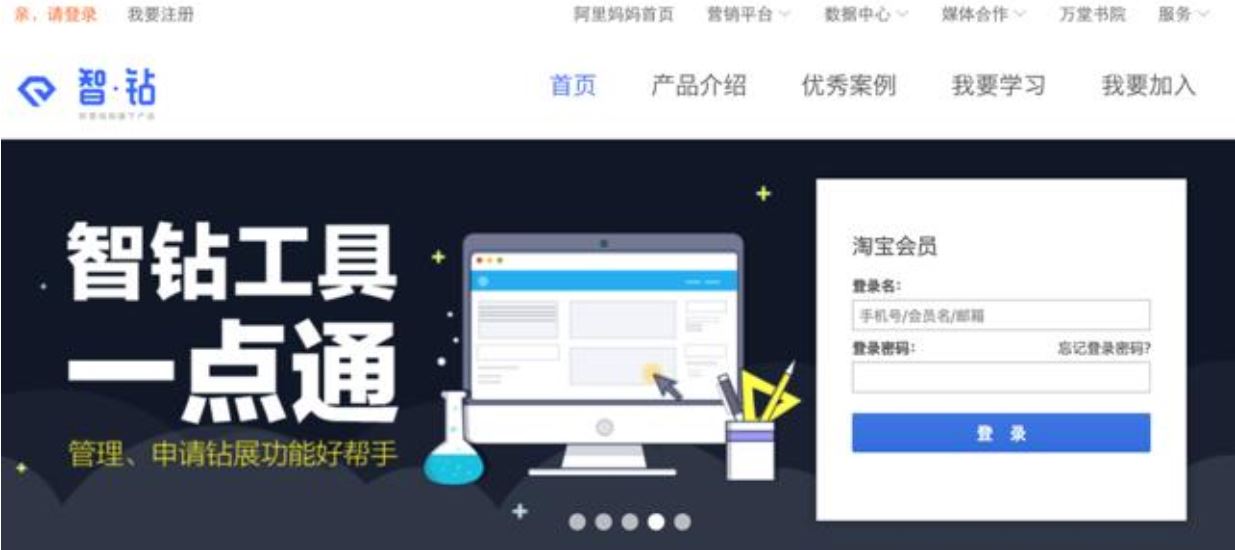 Source: zuanshi.taobao.com
Source: zuanshi.taobao.com
Revenue model: Alimama mainly derives revenue using two methods: cost-per-thousand impressions (CPM) and cost-per-click (CPC).
- CPM: The service fee is calculated according to the number of people that the advertisement reaches.
- CPC: Most services are charged on CPC basis—a business pays the service fee according to the number of times a customer clicks the advertisement.
Strategy and Value Proposition
Highly accurate targeted advertising supported by big data: Alimama leverages the huge volume of data collected by Alibaba’s ecosystem to accurately display marketing content to consumers. This includes transaction data on its marketplaces, payment data on Alipay, logistics data from Cainiao Network, user behavioral data from its media entertainment properties, etc. Alimama’s data-driven brand marketing product, Dharma Sword, helps brands to better target their intended audiences.
Uni Marketing plan for advertising across channels: Alibaba’s Uni Marketing strategy helps brands’ marketing content reach consumers effectively. Alimama’s Uni Marketing plan uses Alibaba’s big data or user profiles to help brands reach potential buyers across all marketing channels. Alimama cooperates with video platforms such as Youku Tudou, social and communication apps such as Weibo, Momo and DingTalk, Internet-based services such as UCWeb and AutoNavi, and search engines.
Peers
Baidu Promote is a pay-for-performance online marketing service introduced by Baidu. The marketing service has gained in popularity from the huge traffic of Baidu, China’s No.1 search engine.
Tencent Social Ads is Tencent’s advertising business which employs its various social networks as marketing channels.
JD JZT is JD.com’s digital marketing platform that was launched in 2014. The company also features marketing solutions based on big data. JZT is collaborating with Tencent to launch a program to provide an integrated e-commerce and social network platform.
 Source: jzt.jd.com
Source: jzt.jd.com
Key metrics
The total number of Alimama users has reached 600 million, as of 2016, according to Caixin.
Outlook
Higher channel integration: Alimama’s future strategy will be premised on helping brands with digital advertising across channels. Uni Marketing will play an important role under New Retail in delivering consumer-centric, data-driven advertising for online and offline merchants.
Expand through partnerships: We expect retailers’ demand for data-driven advertising to increase and that Alimama will further expand through partnerships.
Advancement of Alimama’s digital advertising technology: Alimama can optimize pricing through machine learning and optimally match supply and demand.
Alibaba’s 25 Operation Units
- Network Division
- Client Services Division
- Alimama Advertising Division
- Shopping Search eTao Division
- Tmall Division
- Logistics Division
- Liangwuxian (oo.tmall.com) Division
- Online Travel Division
- Category Operations Divisions
- Digital Content Division
- General Administrative Division
- Consumer Service Division
- Interactive Division
- Mobile Strategy Division
- Alibaba Inventory Management (AliWangwang) and Apps Division
- Music Division
- Group Buying (Juhuasuan.com) Division
- Local Deals Division
- Digital Platforms Division
- Information Platform Division
- Alibaba Mobile OS (yunos.com) Division
- Alibaba Cloud Computing Division
- B2B China Division
- B2B International Division
- B2C International Division

 Source: alibabagroup.com
Source: alibabagroup.com Source: alibabagroup.com
Source: alibabagroup.com Source: world.taobao.com
Source: world.taobao.com Source: dianxiaomi.com
Source: dianxiaomi.com Source: alimarket.taobao.com
Source: alimarket.taobao.com Source: eachnet.com
Source: eachnet.com Source: ymatou.com
Source: ymatou.com Source: Analysys
Source: Analysys Source: tmall.com
Source: tmall.com Source: amazon.cn
Source: amazon.cn Source: Analysys
Source: Analysys Source: Analysys
Source: Analysys Source: ju.tmall.com
Source: ju.tmall.com Source: jusp.tmall.com
Source: jusp.tmall.com Source: 1688.com
Source: 1688.com Source: cxt.1688.com
Source: cxt.1688.com Source: cxt.1688.com
Source: cxt.1688.com Source: hc360.com
Source: hc360.com Source: iResearch
Source: iResearch Source: aliexpress.com
Source: aliexpress.com Source: amazon.com
Source: amazon.com Source: ebay.com
Source: ebay.com Source: alibaba.com
Source: alibaba.com Source: home.kuehne-nagel.com
Source: home.kuehne-nagel.com Source: thomasnet.com
Source: thomasnet.com Source: alibabagroup.com
Source: alibabagroup.com Source: lazada.com.my
Source: lazada.com.my Source: tokopedia.com
Source: tokopedia.com Source: shopee.sg
Source: shopee.sg Source: alibabapictures.com
Source: alibabapictures.com Source: taobao.com
Source: taobao.com Source: dianying.taobao.com
Source: dianying.taobao.com Source: huayibrothersent.com
Source: huayibrothersent.com Source: xiami.com
Source: xiami.com Source: mp3.sogou.com
Source: mp3.sogou.com Source: alisports.com
Source: alisports.com Source: sports.qq.com
Source: sports.qq.com Source: 2017.wesg.com
Source: 2017.wesg.com Source: c.youku.com
Source: c.youku.com Source: iqiyi.com
Source: iqiyi.com Source: uc.cn
Source: uc.cn Source: mb.qq.com
Source: mb.qq.com Source: dingtalk.com
Source: dingtalk.com Source: yonyou.com
Source: yonyou.com Source: 263.net
Source: 263.net Source: Analysys
Source: Analysys Source: iResearch
Source: iResearch Source: yunos.com
Source: yunos.com Source: yunos.com
Source: yunos.com Source: bbs.tos.cn
Source: bbs.tos.cn Source: miui.com
Source: miui.com Source: autonavi.com
Source: autonavi.com Source: Baidu Map IOS App
Source: Baidu Map IOS App Source: Analysys
Source: Analysys Source: auto.amap.com
Source: auto.amap.com Source: alihealth.cn
Source: alihealth.cn Source: doctor.qq.com
Source: doctor.qq.com Source: koubei.com
Source: koubei.com Source: dianping.com
Source: dianping.com Source: global.cainiao.com
Source: global.cainiao.com Source: wuliu.suning.com
Source: wuliu.suning.com Source: antfin.com
Source: antfin.com Source: pay.weixin.qq.com
Source: pay.weixin.qq.com Source: paypal.com
Source: paypal.com Source: 360doc/FGRT
Source: 360doc/FGRT Source: alipay.com
Source: alipay.com Source: Alipay company website
Source: Alipay company website Source: tenpay.com
Source: tenpay.com Source: cn.unionpay.com
Source: cn.unionpay.com Source: apple.com/apple-pay
Source: apple.com/apple-pay Source: FGRT
Source: FGRT Source: cn.aliyun.com
Source: cn.aliyun.com Source: azure.microsoft.com
Source: azure.microsoft.com Source: alimama.com
Source: alimama.com Source: tanx.com
Source: tanx.com Source: zhitongche.taobao.com
Source: zhitongche.taobao.com Source: zuanshi.taobao.com
Source: zuanshi.taobao.com Source: jzt.jd.com
Source: jzt.jd.com